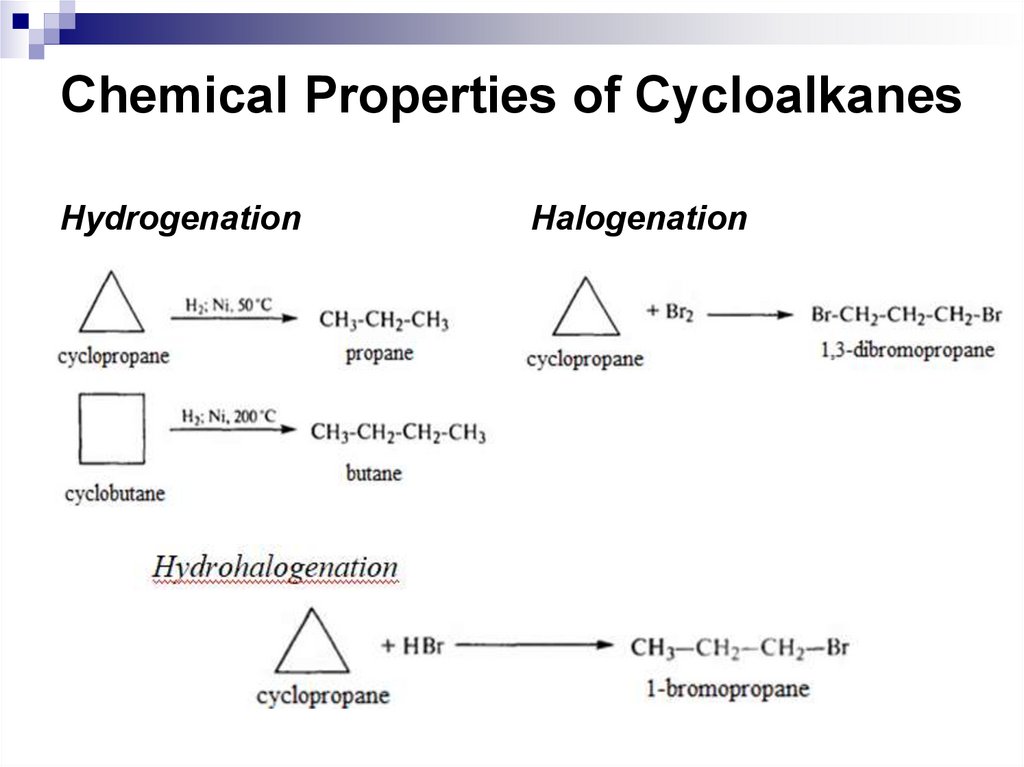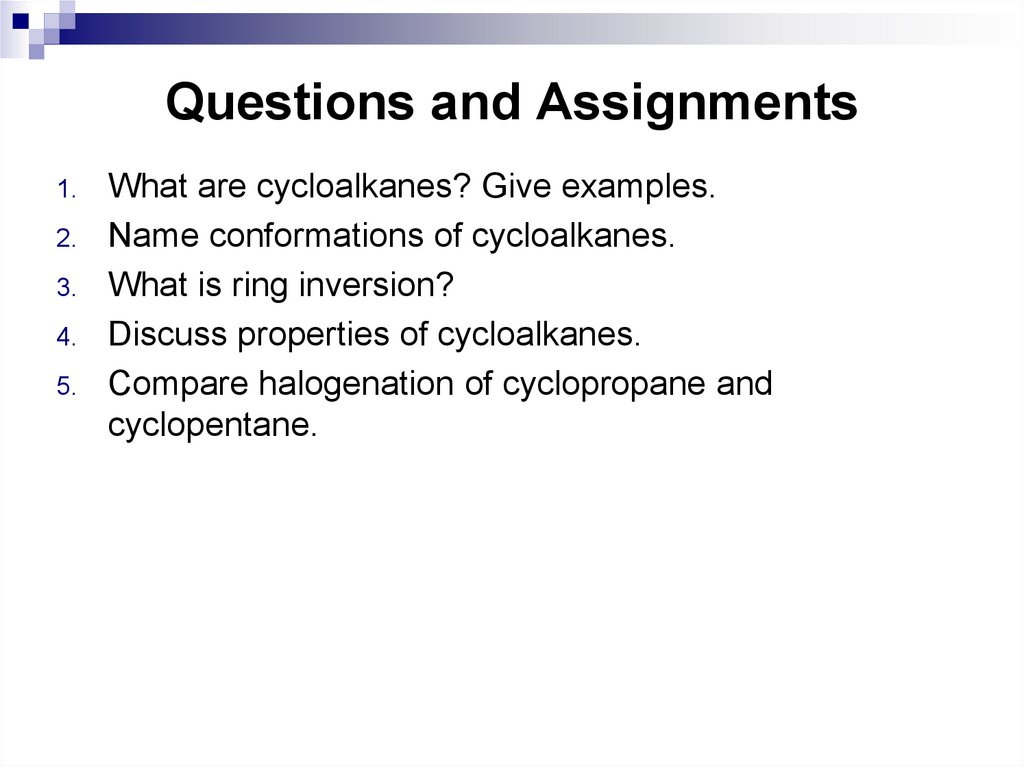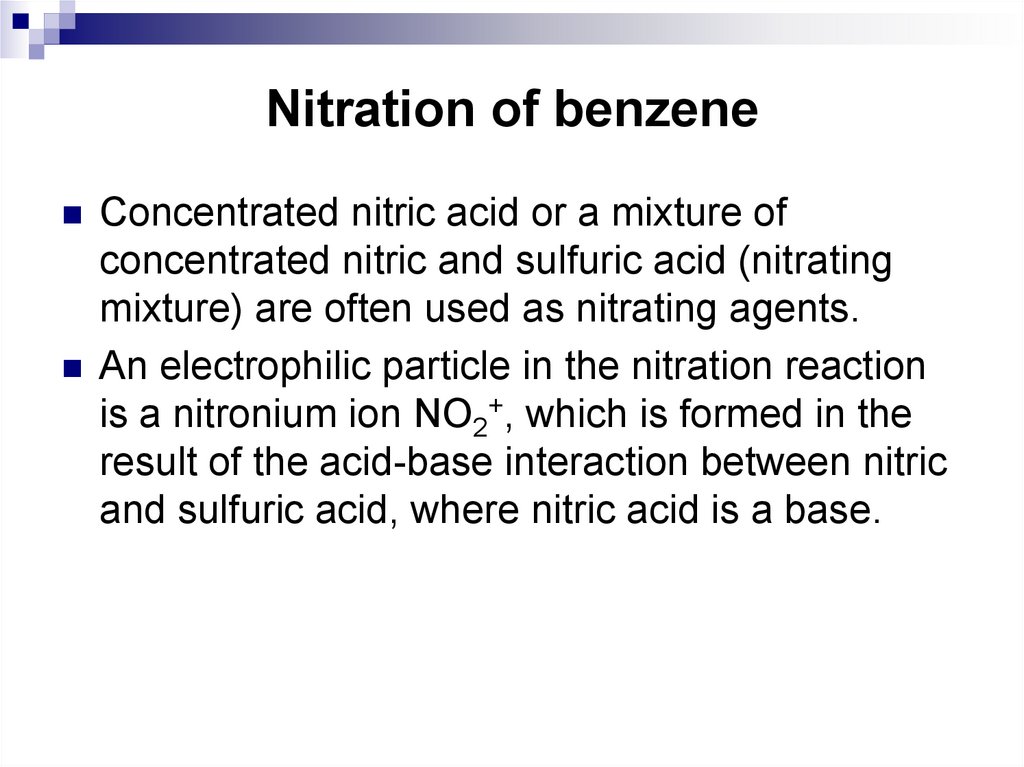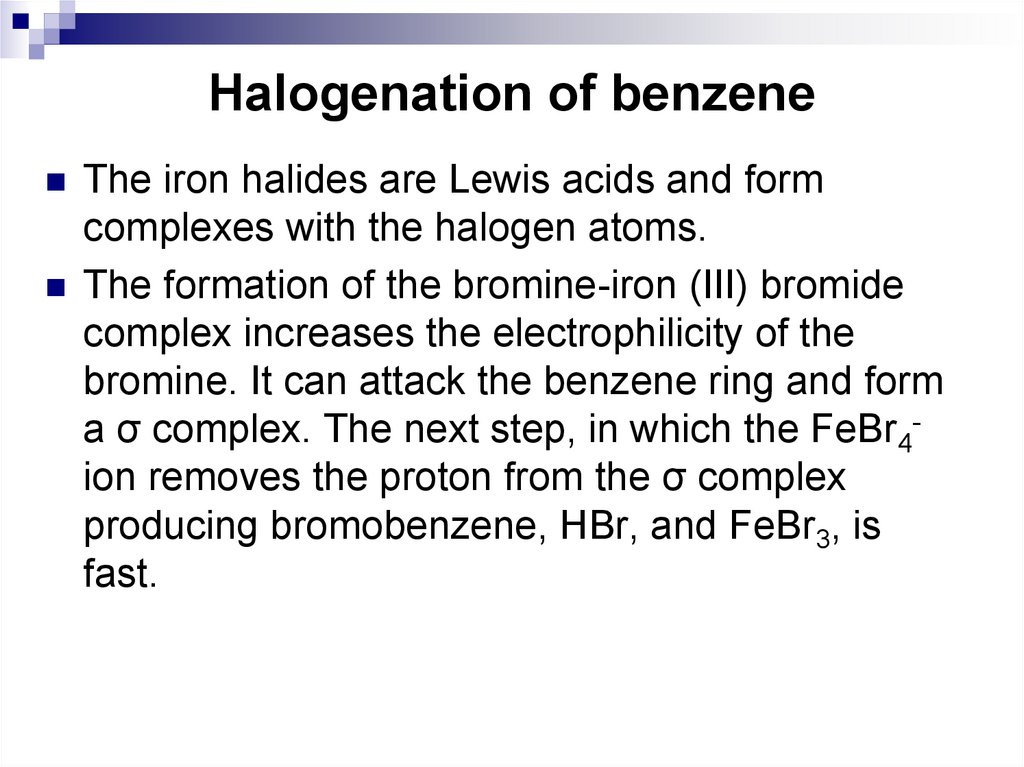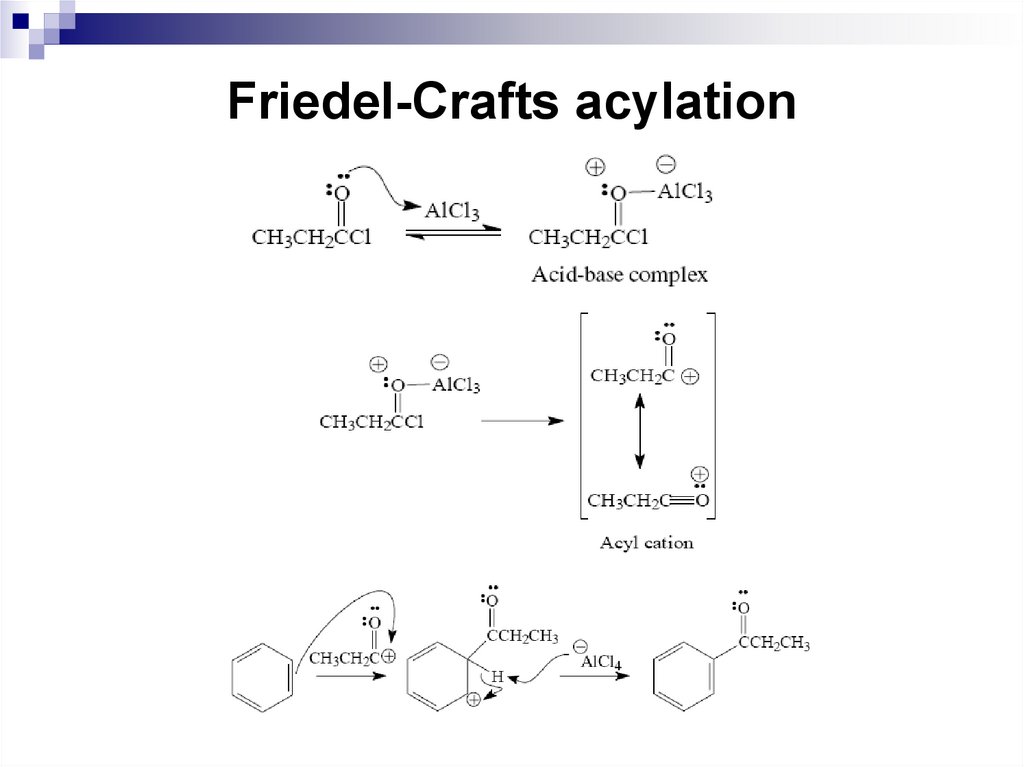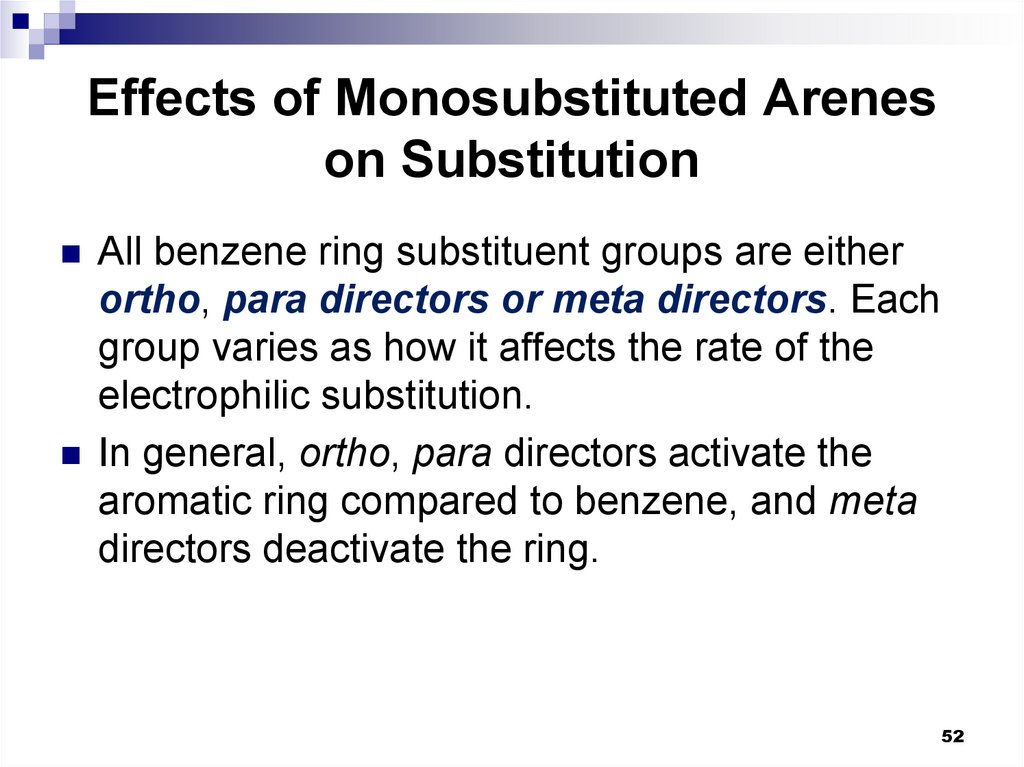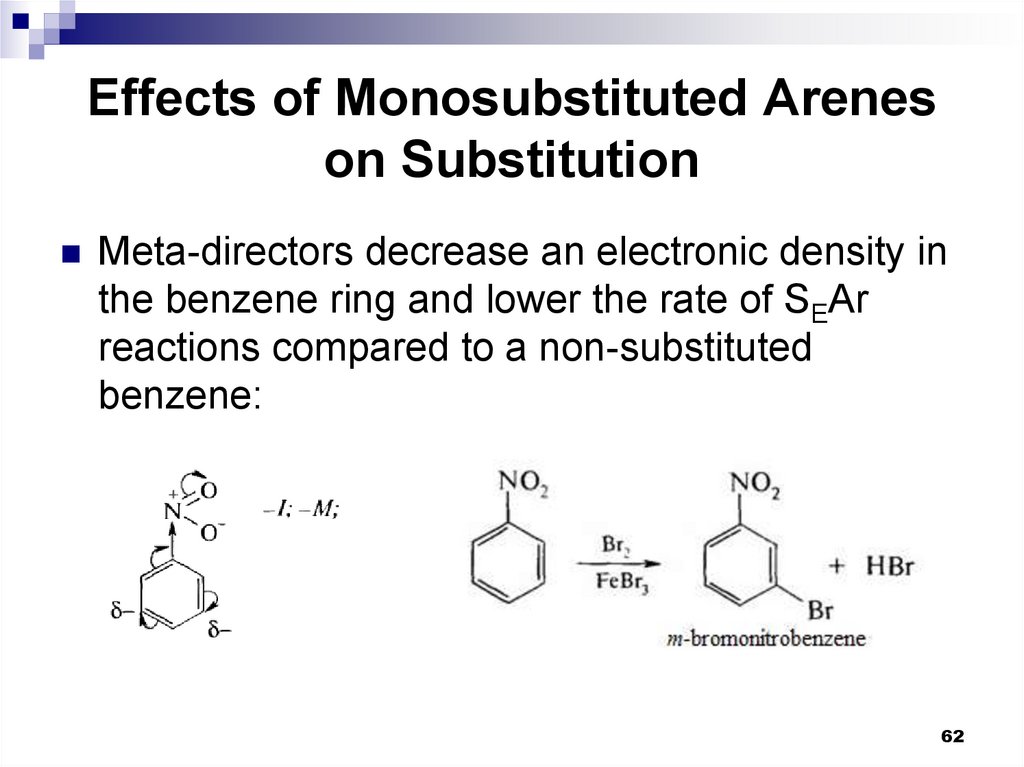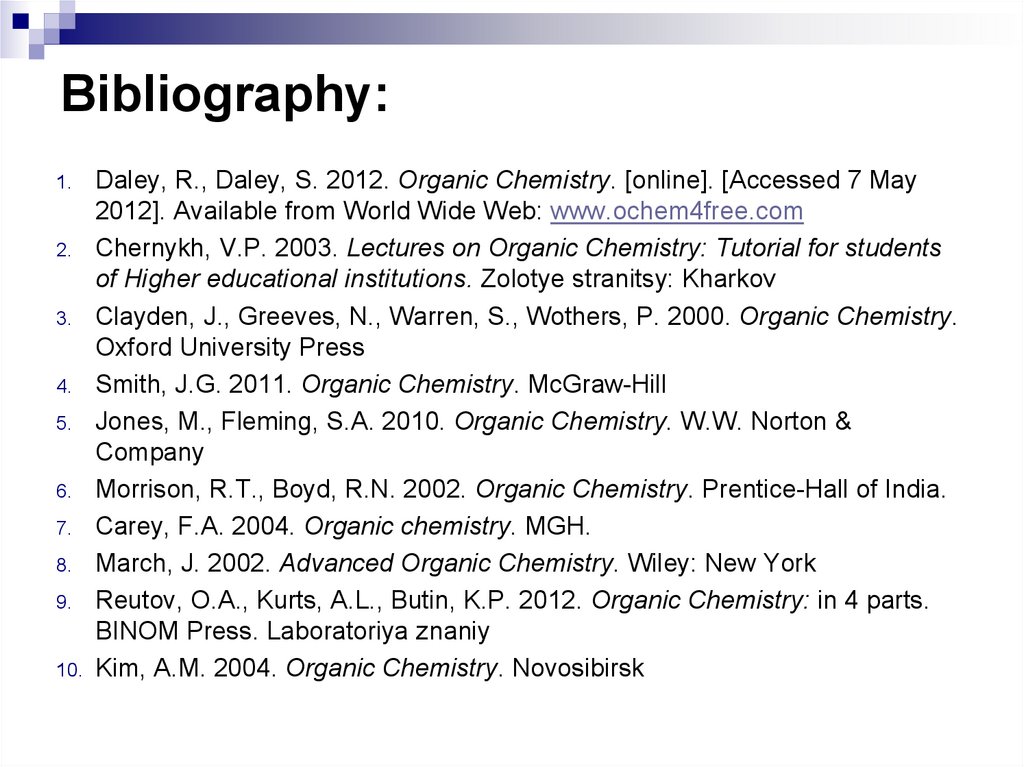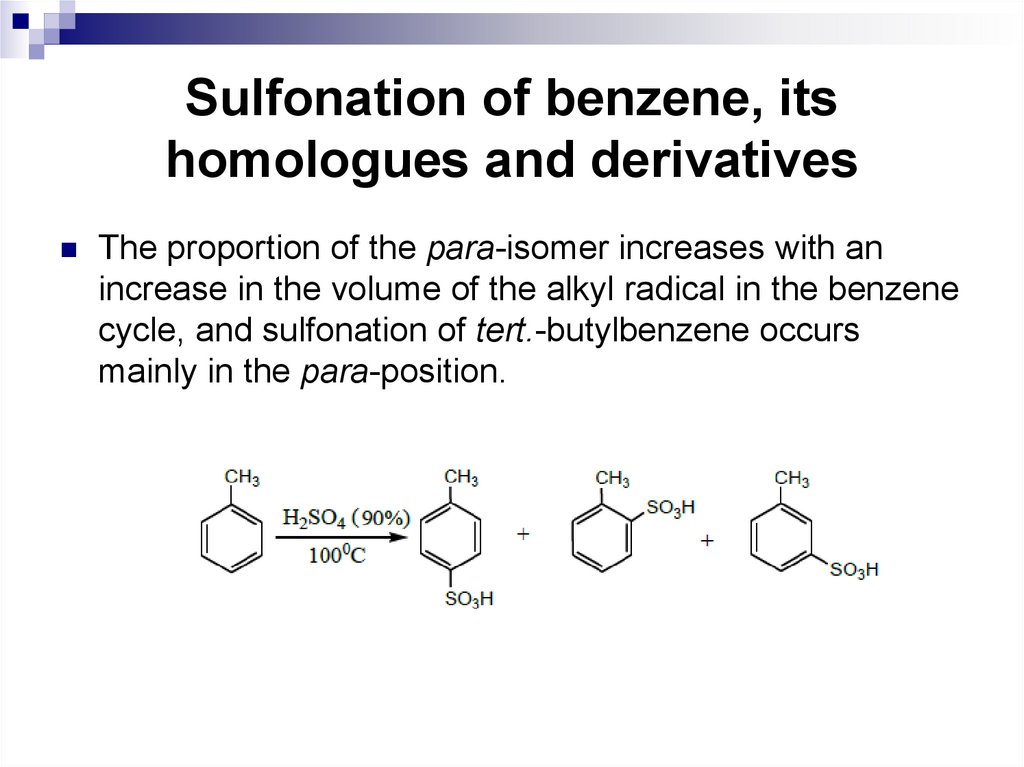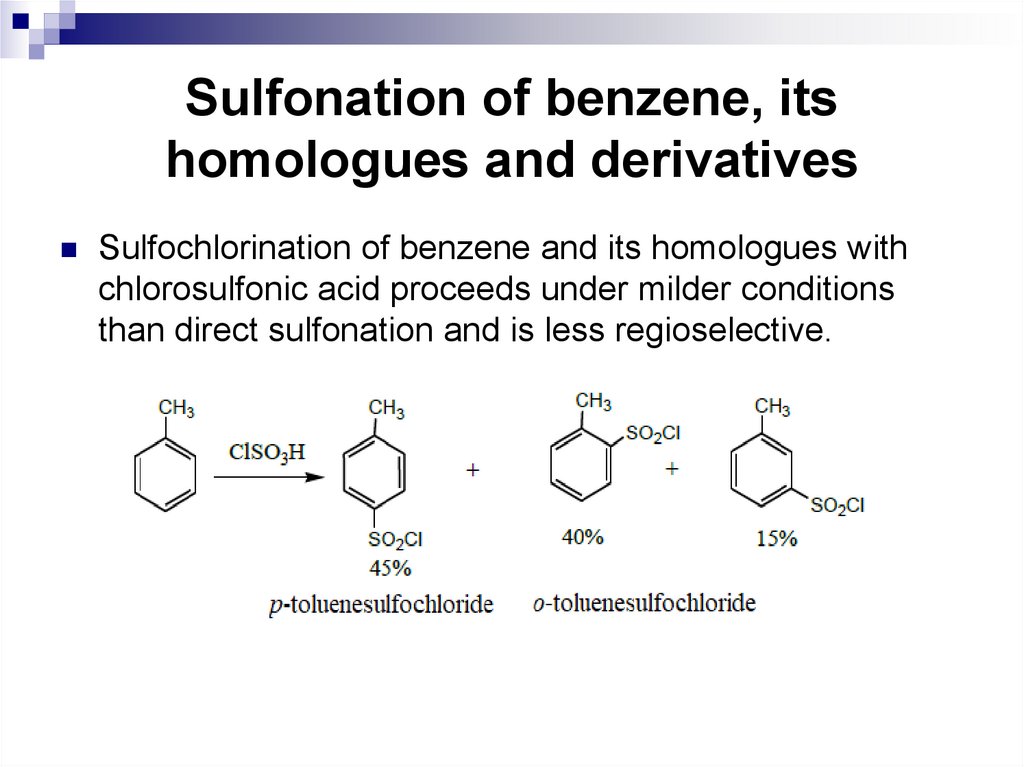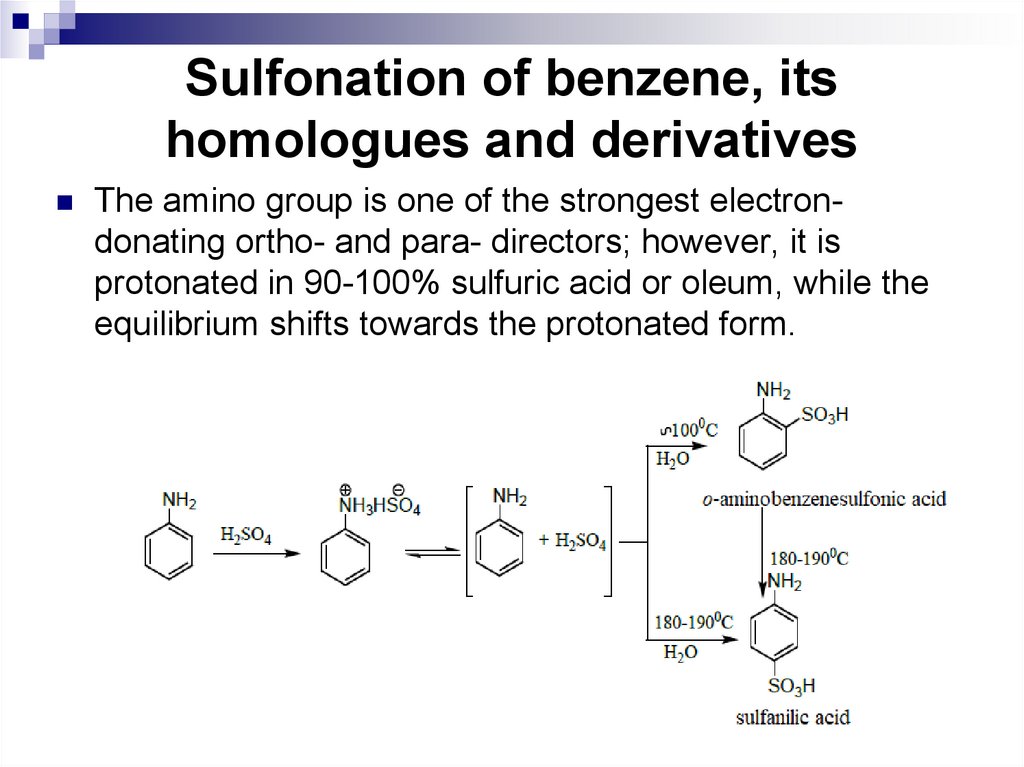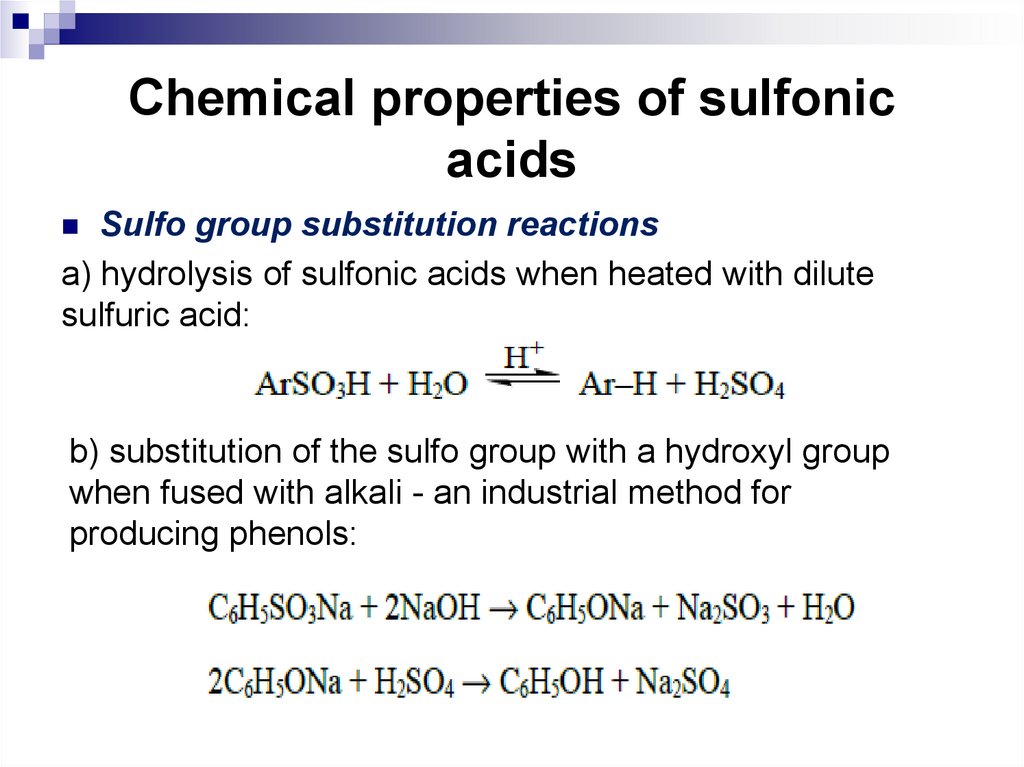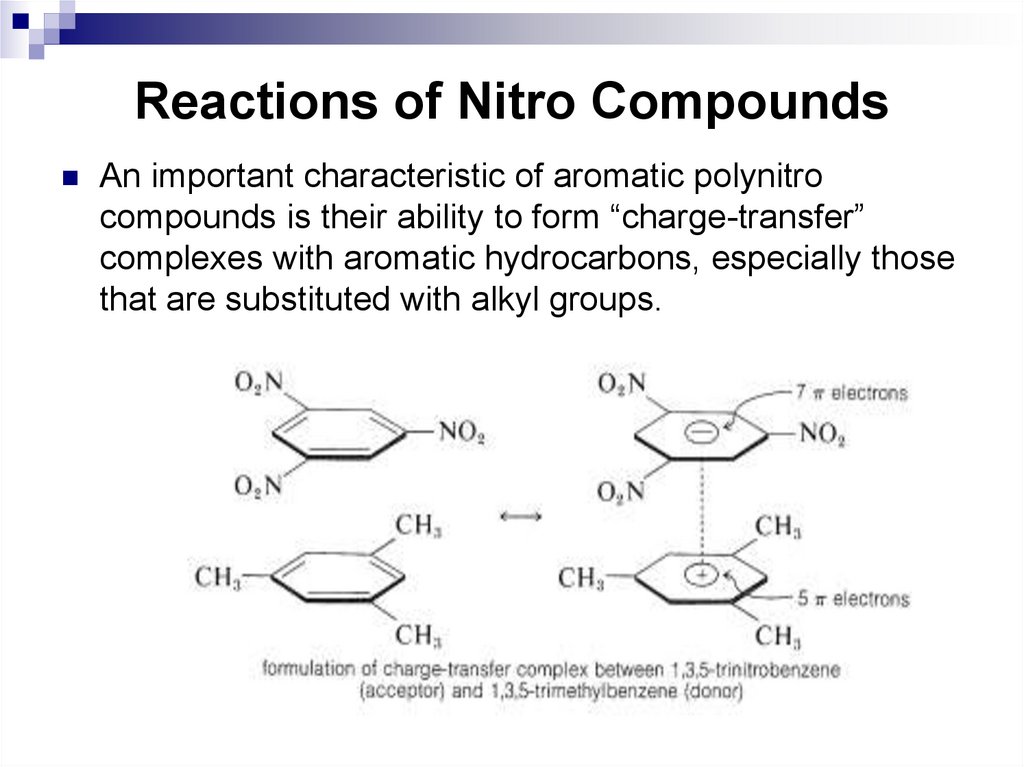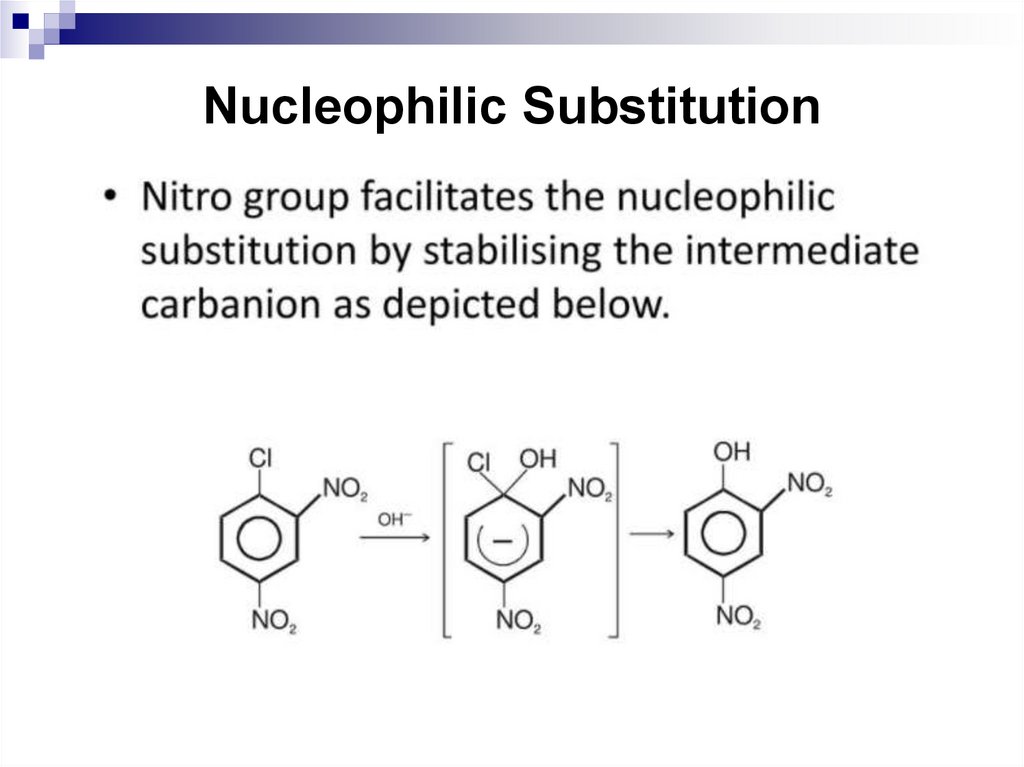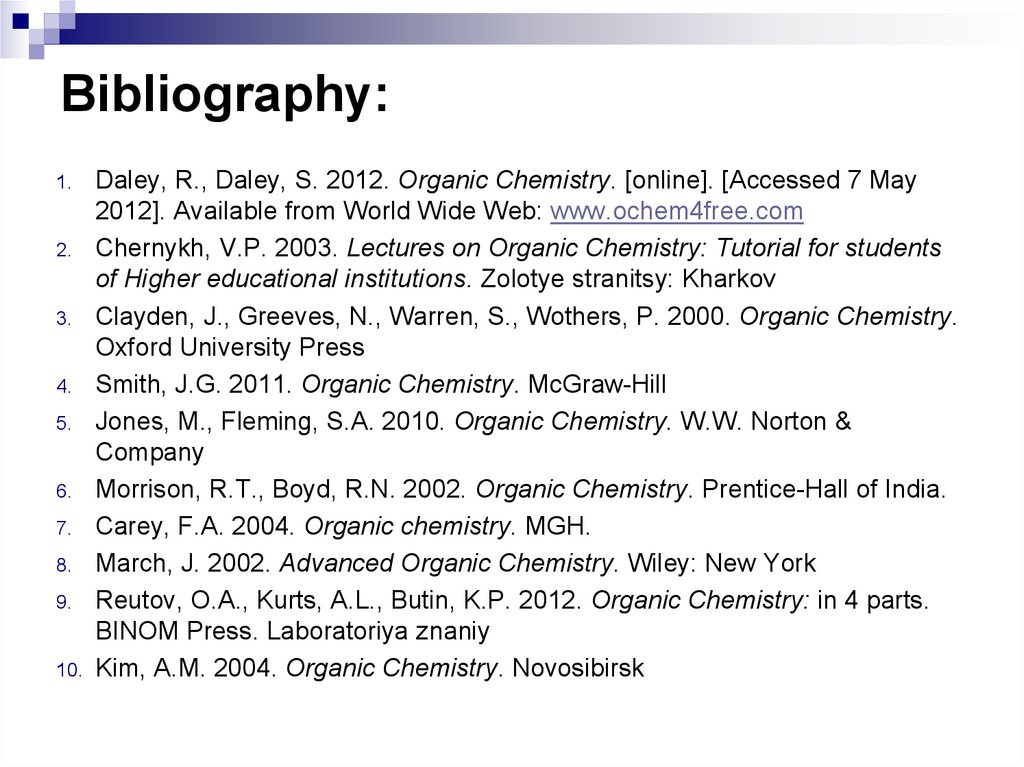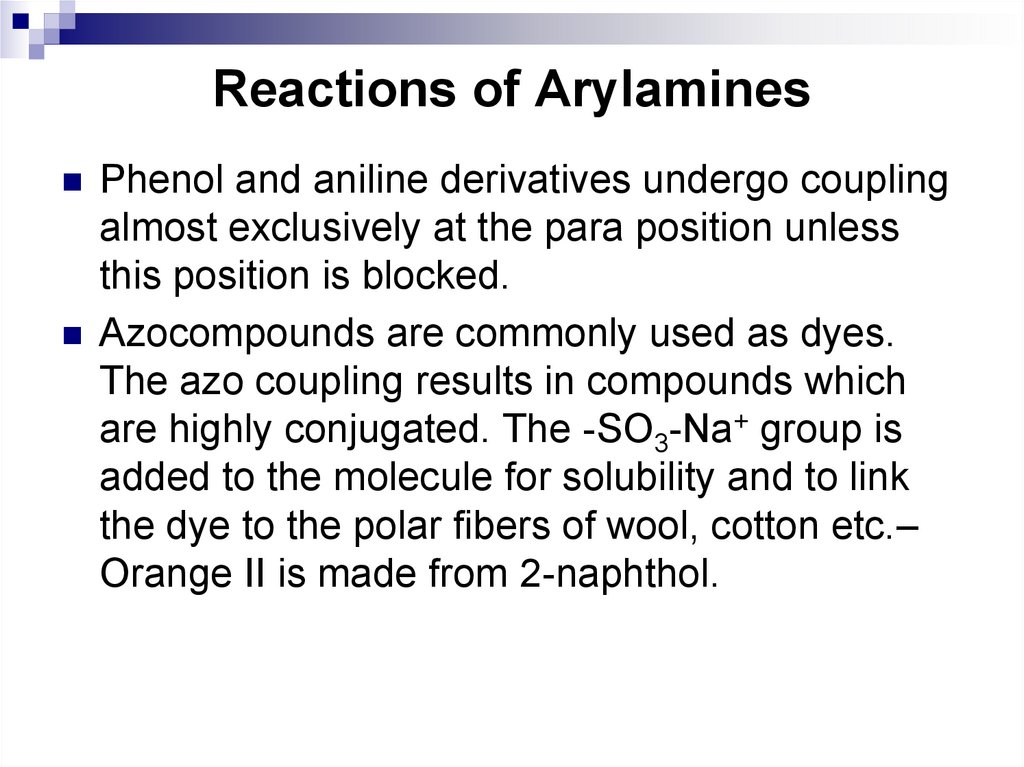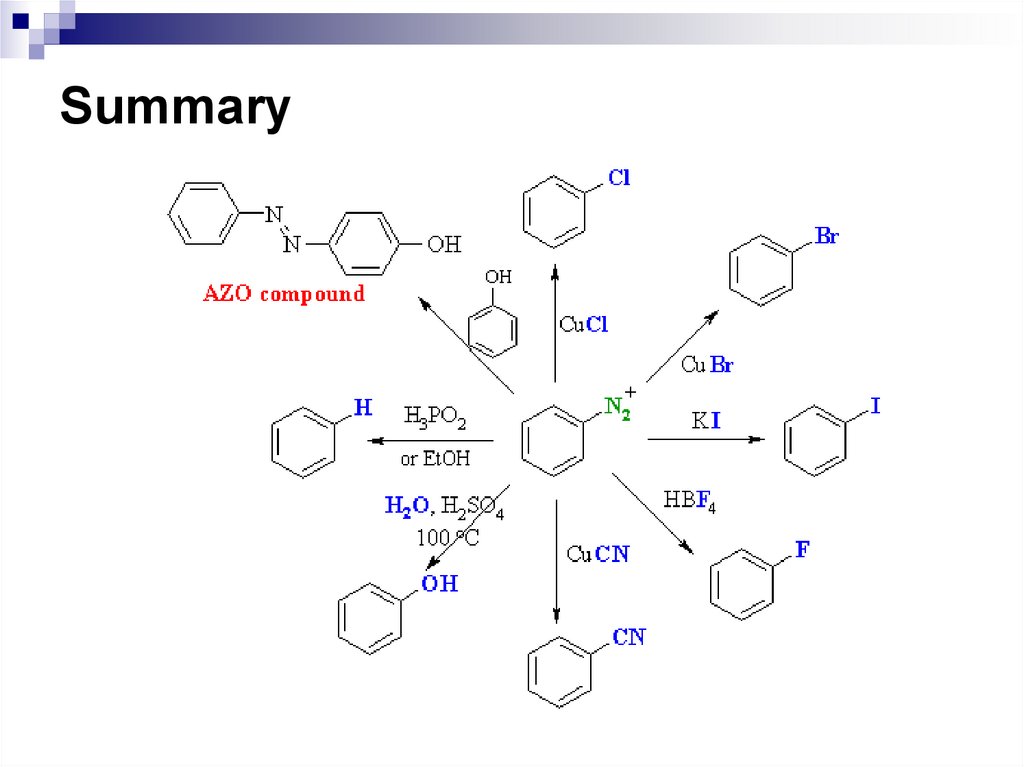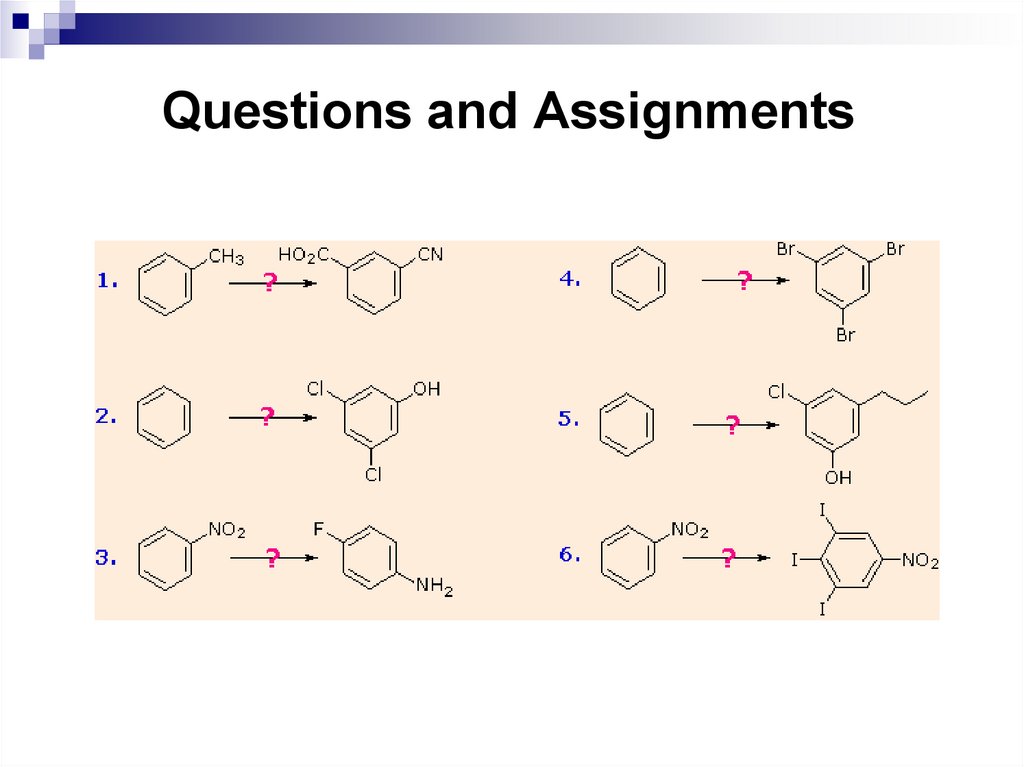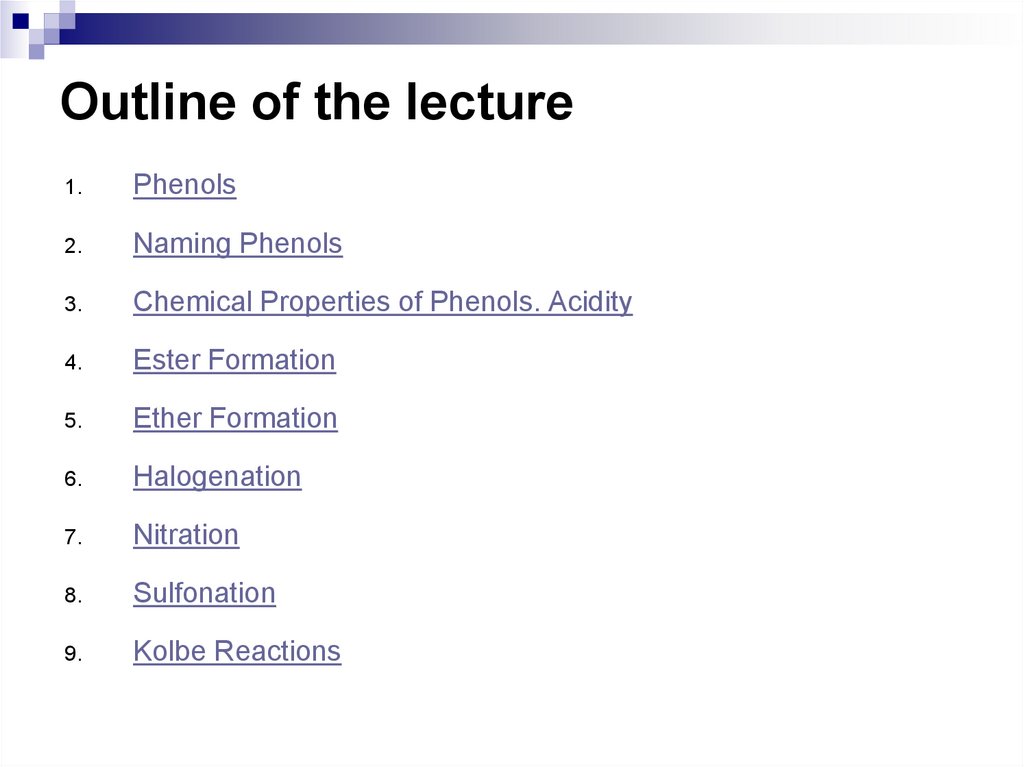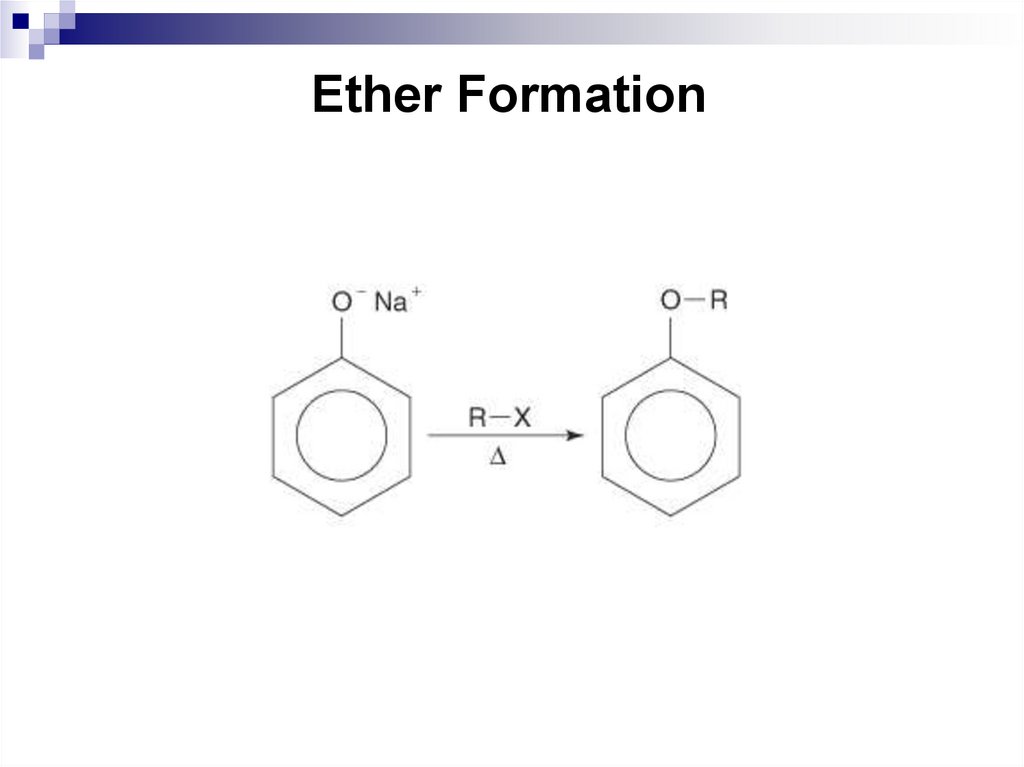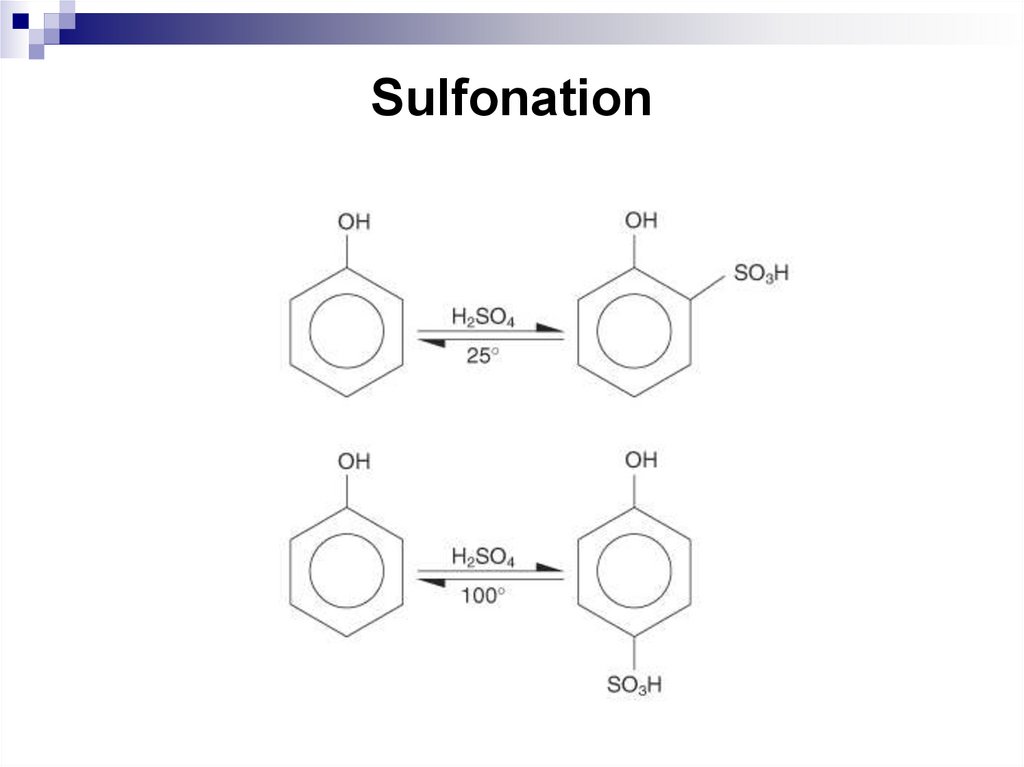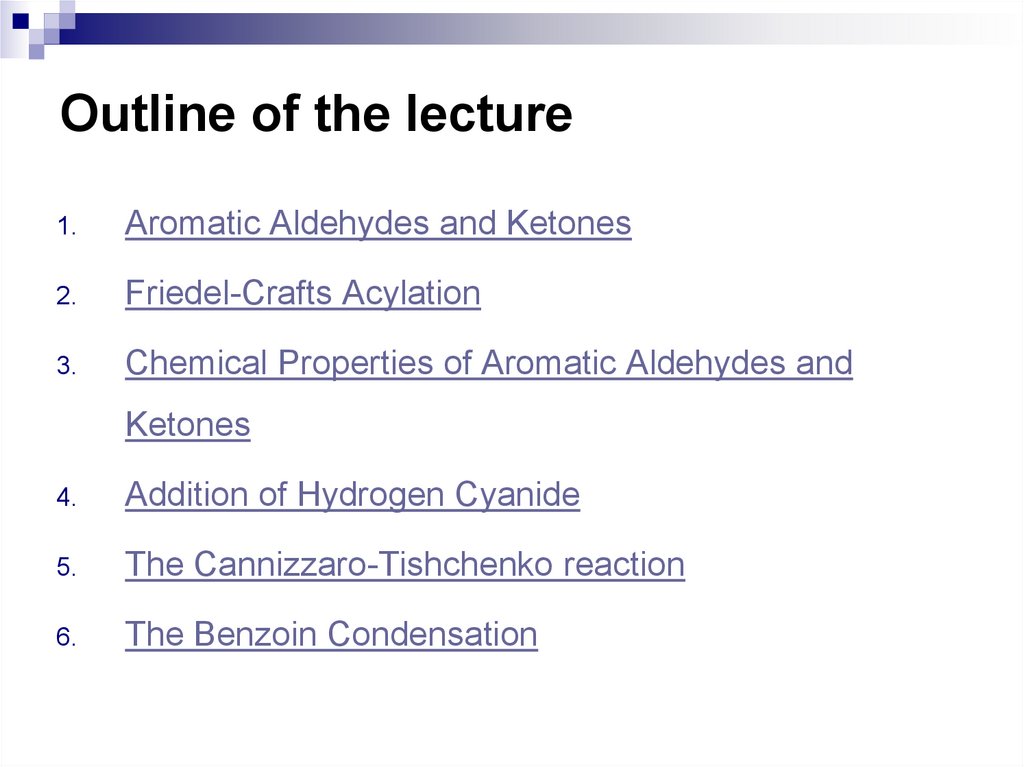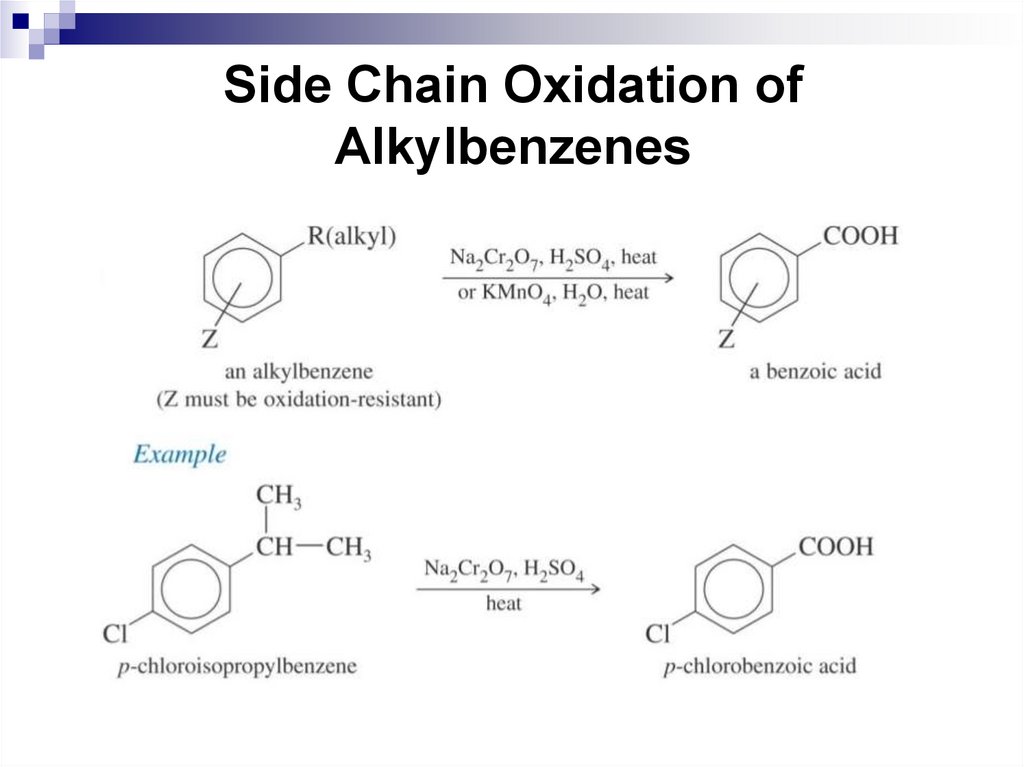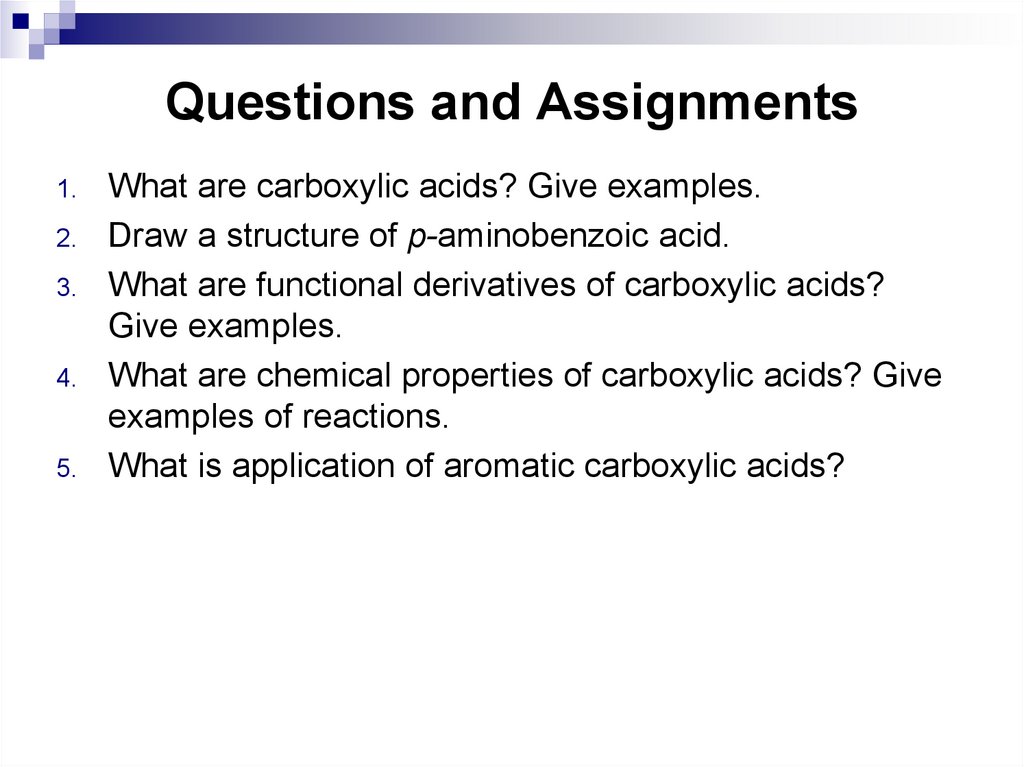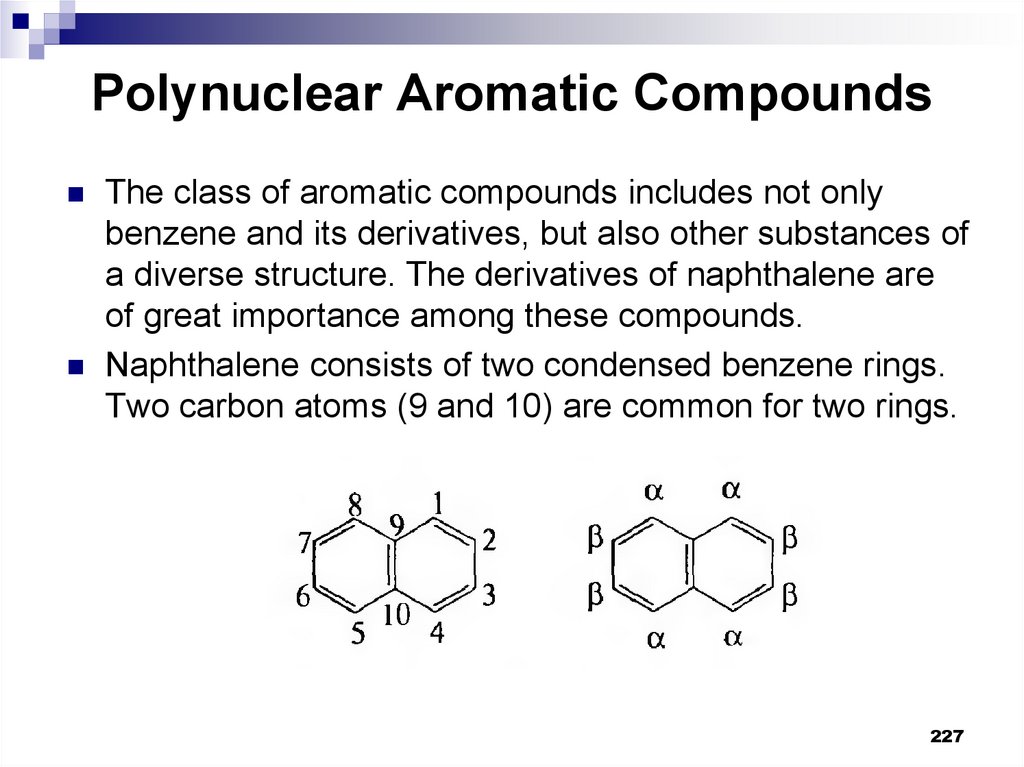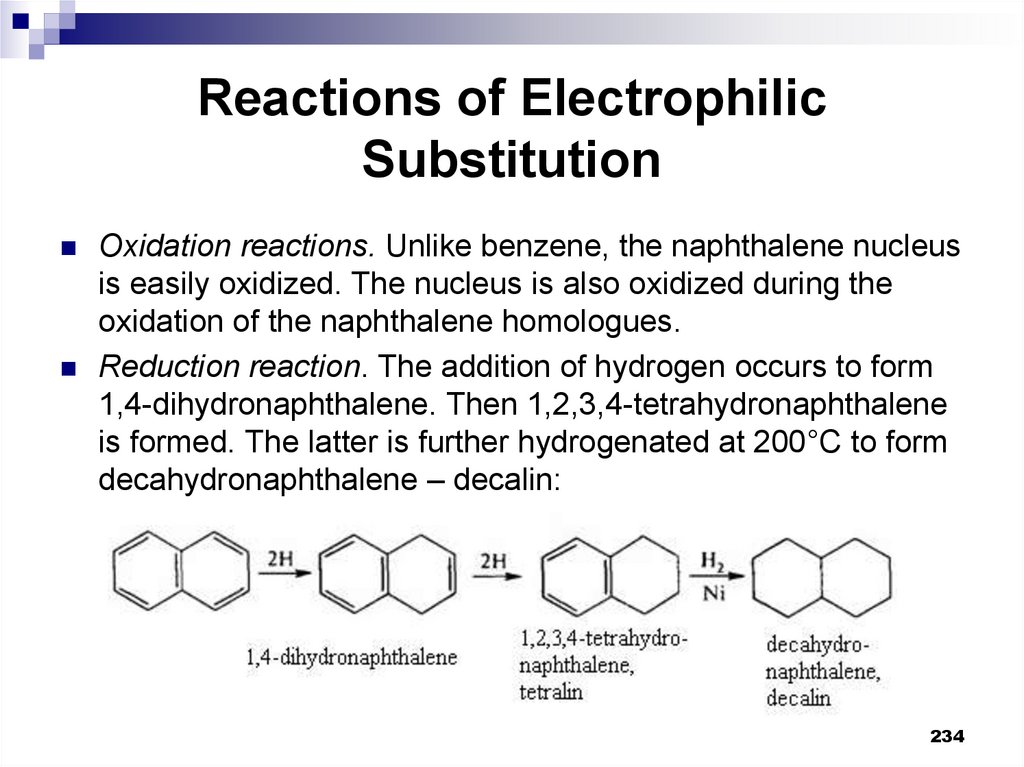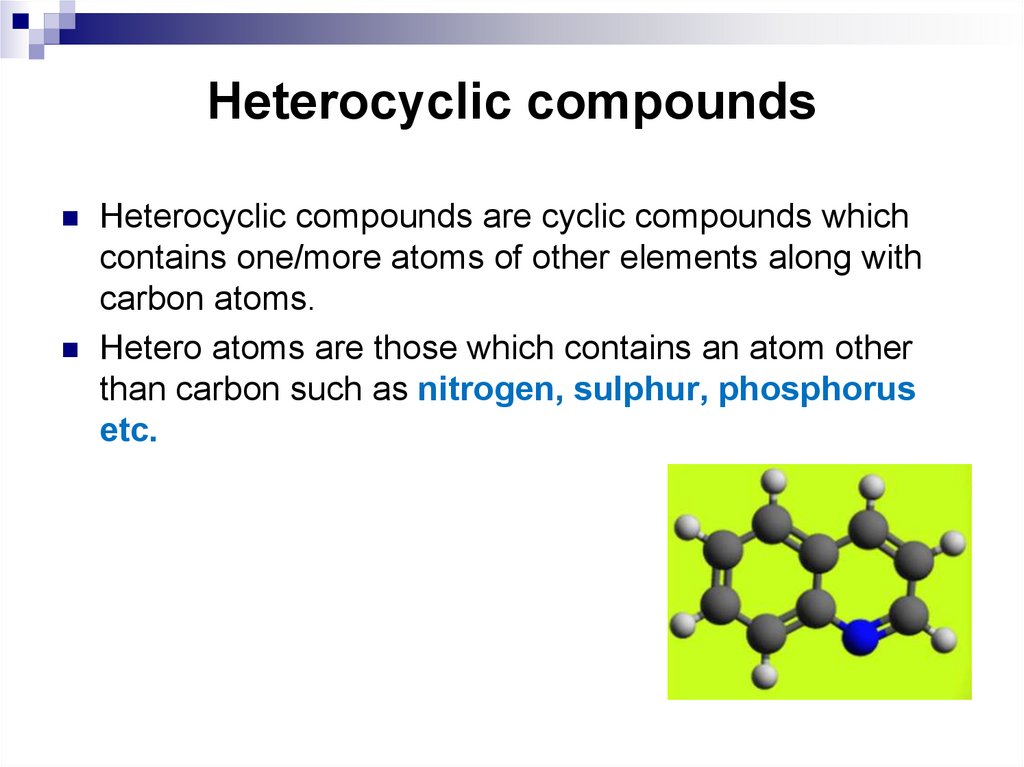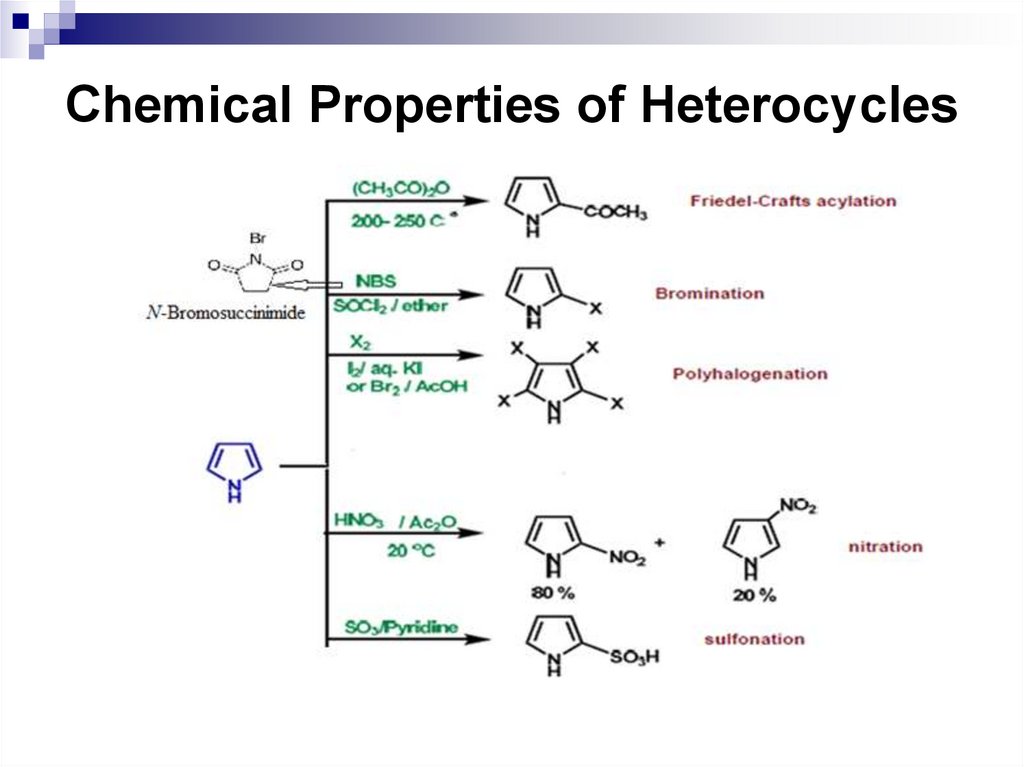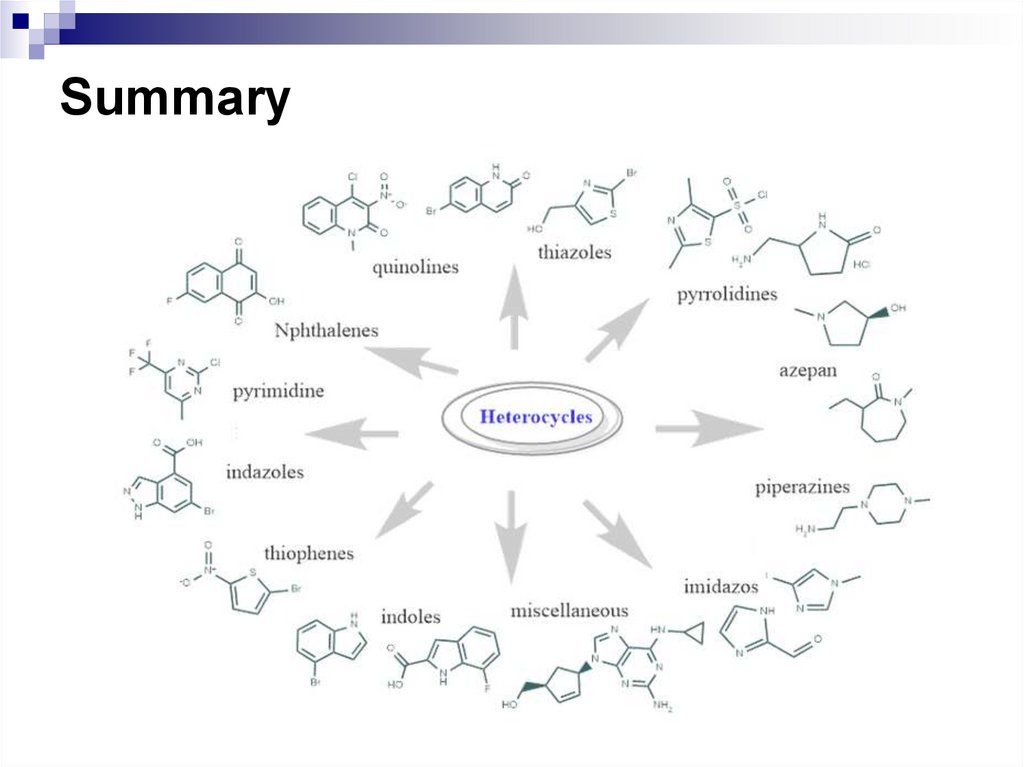Похожие презентации:
Conformational Analysis of Organic Compounds
1. Conformational Analysis of Organic Compounds
Ministry of Education and Science of the Republic of KazakhstanKaraganda Buketov University
Conformational Analysis of
Organic Compounds
Minayeva Ye.V, Ph.D., Associate Professor of the Department of Organic Chemistry
and Polymers
Type of lessons: lecture
Karaganda 2022
2. Course Topics
Topic 1. CycloalkanesTopic 2. Aromatic Hydrocarbons (Arenes)
Topic 3. Halogenated Aromatic Hydrocarbons
Topic 4. Aromatic Sulfonic Acids
Topic 5. Aromatic Nitro Compounds
Topic 6. Aromatic Amines
Topic 7. Diazo and azo compounds
Topic 8. Phenols
Topic 9. Aromatic Aldehydes and Ketones
Topic 10. Aromatic Carboxylic Acids and Their Derivatives
Topic 11. Polynuclear Aromatic Compounds
Topic 12. Heterocycles
3. Cycloalkanes
Topic 14. Outline of the lecture
1.Cycloalkanes
2.
Naming Cycloalkanes
3.
Conformations of Cycloalkanes
4.
Chemical Properties of Cycloalkanes
5. Bibliography:
1.2.
3.
4.
5.
6.
7.
8.
9.
10.
11.
Daley, R., Daley, S. 2012. Organic Chemistry. [online]. [Accessed 7 May
2012]. Available from World Wide Web: www.ochem4free.com
Chernykh, V.P. 2003. Lectures on Organic Chemistry: Tutorial for students
of Higher educational institutions. Zolotye stranitsy: Kharkov
Clayden, J., Greeves, N., Warren, S., Wothers, P. 2000. Organic Chemistry.
Oxford University Press
Smith, J.G. 2011. Organic Chemistry. McGraw-Hill
Jones, M., Fleming, S.A. 2010. Organic Chemistry. W.W. Norton &
Company
Morrison, R.T., Boyd, R.N. 2002. Organic Chemistry. Prentice-Hall of India.
Carey, F.A. 2004. Organic chemistry. MGH.
March, J. 2002. Advanced Organic Chemistry. Wiley: New York
Reutov, O.A., Kurts, A.L., Butin, K.P. 2012. Organic Chemistry: in 4 parts.
BINOM Press. Laboratoriya znaniy
Kim, A.M. 2004. Organic Chemistry. Novosibirsk
https://www.masterorganicchemistry.com/2018/01/29/ortho-para-and-metadirectors-in-electrophilic-aromatic-substitution/
6. Cycloalkanes
Cycloalkanes are hydrocarbons that have the generalmolecular formula CnH2n and in which some, or all, of the
carbon atoms form a ring.
7. Cycloalkanes
Cycloalkanes are classified according to the cycle size, the numberof cycles, and the way the cycles are connected in the molecule.
According to the cycle size there are distinguished:
• cycloalkanes with small cycles (three- and four-membered);
• cycloalkanes with ordinary cycles (five-, six- and sevenmembered);
• cycloalkanes with medium cycles (from eight to eleven members);
• macrocycles.
Depending on the number of cycles in the molecule, there are
found:
• monocyclic
• bicyclic
• polycyclic cycloalkanes
8. Naming cycloalkanes
In order to name cycloalkanes,determine the parent name of
the compound by counting the
number of carbons in the ring as
for alkanes and add the prefix
cyclo- to the parent name.
Further determine the position
of the alkyl group or groups on
the ring and name them.
9. Naming cycloalkanes
When a ring has morethan one alkyl group
attached, number the ring
to give the lowest sum of
numbers. If the sum of
numbers is identical
either direction around
the ring, then count
towards the second group
alphabetically on the ring.
10. Structure and isomerism of cycloalkanes
The structural isomerism ofcycloalkanes is determined by the size
of the cycle, the nature and mutual
arrangement of substituents:
The geometric isomerism of
cycloalkanes is due to the different
arrangement of substituents relative to
the ring plane.
11. Conformations of cycloalkanes
The molecule of any cycloalkane tends to occupy in spacesuch a form (conformation) in which the sum of angle,
torsional and van der Waals strains would be minimal.
With the exception of cyclopropane, the rings of all
cycloalkanes are nonplanar. Cyclopropane is planar and
destabilized by angle strain and torsional strain. Other
molecules of cycloalkanes adopt the shape that minimizes the
angle strain.
Angle strain is destabilization that results from distortion of
bond angles from their normal values.
Torsional strain is destabilization that results when bonds on
adjacent atoms are not staggered.
12. Stereochemistry of Cycloalkanes
https://en.wikipedia.org/wiki/Bent_bond12
13. Stereochemistry of Cycloalkanes
https://www.dummies.com/education/science/chemistry/how-to-drawthe-chair-conformation-of-cyclohexane/13
14. Stereochemistry of Cycloalkanes
15. Conformations of cycloalkanes
16. Conformations of cycloalkanes
The chair conformation ofcyclohexane has two
distinct types of carbonhydrogen bonds, namely,
axial and equatorial
ones. Six of these bonds
are axial and the other six
are equatorial ones, with
one axial and one
equatorial bond on each
carbon.
17. Conformations of cycloalkanes
Through a process called ring inversion, or chair-boat-chairinterconversion, one chair form of cyclohexane converts to
another chair form of cyclohexane. In this process of ring
flipping, the equatorial substituents become axial, and the
axial substituents become equatorial.
18. Conformations of cycloalkanes
The process of ringinversion takes
cyclohexane through
a conformation called
the half-chair
conformation.
19. Methods for obtaining cycloalkanes
1. Interaction of , -dihaloalkanes with metallic sodium and zinc. Thismethod is an intramolecular version of the Wurtz reaction, which makes
it possible to obtain three-, four-, and five-membered cycloalkanes.
2. Pyrolysis of calcium, barium or thorium salts of dicarboxylic acids.
During pyrolysis (dry distillation) of dicarboxylic acids salts, cyclic
ketones are formed, which are then reduced to the corresponding
cycloalkanes.
20. Methods for obtaining cycloalkanes
3. Cycloaddition. This is the process of combining two or moreunsaturated molecules to form a product of a cyclic structure. For
example, dimerization of alkenes ([2+2] cycloaddition) makes it
possible to obtain cyclobutane and its homologues.
21. Methods for obtaining cycloalkanes
4. Electrocyclic reactions. An electrocyclic ring-closingreaction is a reaction in which a -bond is formed between
the ends of the conjugated system of a molecule.
22. Chemical Properties of Cycloalkanes
Free radical substitution reactions (SR) arecharacteristic for cycloalkanes:
23. Chemical Properties of Cycloalkanes
HydrogenationHalogenation
24. Summary
This lecture considers cycloalkanes, conformations ofcycloalkanes as well as their chemical properties.
25. Questions and Assignments
1.2.
3.
4.
5.
What are cycloalkanes? Give examples.
Name conformations of cycloalkanes.
What is ring inversion?
Discuss properties of cycloalkanes.
Compare halogenation of cyclopropane and
cyclopentane.
26. Aromatic Hydrocarbons (Arenes)
Topic 227. Outline of the lecture
1.Aromaticity. Hückel's Rule
2.
Benzene and its Derivatives
3.
Nomenclature and isomerism of benzene
derivatives
4.
Chemical Properties of Benzene and its
Derivatives
28. Bibliography:
1.2.
3.
4.
5.
6.
7.
8.
9.
10.
11.
Daley, R., Daley, S. 2012. Organic Chemistry. [online]. [Accessed 7 May
2012]. Available from World Wide Web: www.ochem4free.com
Chernykh, V.P. 2003. Lectures on Organic Chemistry: Tutorial for students
of Higher educational institutions. Zolotye stranitsy: Kharkov
Clayden, J., Greeves, N., Warren, S., Wothers, P. 2000. Organic Chemistry.
Oxford University Press
Smith, J.G. 2011. Organic Chemistry. McGraw-Hill
Jones, M., Fleming, S.A. 2010. Organic Chemistry. W.W. Norton &
Company
Morrison, R.T., Boyd, R.N. 2002. Organic Chemistry. Prentice-Hall of India.
Carey, F.A. 2004. Organic chemistry. MGH.
March, J. 2002. Advanced Organic Chemistry. Wiley: New York
Reutov, O.A., Kurts, A.L., Butin, K.P. 2012. Organic Chemistry: in 4 parts.
BINOM Press. Laboratoriya znaniy
Kim, A.M. 2004. Organic Chemistry. Novosibirsk
https://www.masterorganicchemistry.com/2018/02/02/understanding-orthopara-meta-directors/
29. Aromaticity. Hückel's Rule. Benzene and its Derivatives
Aromatic compounds are compounds, whichcontain cyclic conjugated -electron systems, that
meet the criteria of aromaticity. To be aromatic, a
compound must be cyclic and the π electrons must
be delocalized over the entire ring. The structure of
the compound must be planar, or nearly planar.
30. Aromaticity. Hückel's Rule
Hückel's ruleHückel postulated that the number of
delocalized π electrons contained in the
molecule determined whether or not the
molecule was aromatic. He suggested that
the number of π electrons needed for
aromaticity was 4N + 2 electrons (N is any
integer value. N=0, 1, 2, …).
31. Aromatic ions
A number of cyclic species that bear a positive ornegative charge exhibit unusual stability that suggests they
are aromatic. These ions meet Hückel's rule, further
indicating that they are aromatic.
Because of the unusual stability of the cyclopentadienyl
anion, and because these six π electrons meet the criteria
for Hückel's rule, the cyclopentadienyl anion is considered
to be an aromatic ion.
32. Benzene and its Derivatives
33. Benzene and its Derivatives
34. Benzene and its Derivatives
35. Benzene and its Derivatives
36. Nomenclature and isomerism of benzene derivatives
According to the IUPAC nomenclature arenesare considered as derivatives of benzene.
When two substituents are present in a benzene
ring, three isomers are possible; they can be
distinguished by numbering the atoms of the ring
or using the ortho (o), meta (m), and para (p)
system.
When a benzene ring is the substituent, use the
phenyl group name.
37. Nomenclature and isomerism of benzene derivatives
38. Chemical Properties of Benzene and its Derivatives
39. Chemical Properties of Benzene and its Derivatives
This reaction type is called an electrophilicaromatic substitution. The most important
SEAr reactions are nitration, sulfonation,
halogenation, alkylation, and acylation.
40. Chemical Properties of Benzene and its Derivatives
41. Nitration of benzene
Concentrated nitric acid or a mixture ofconcentrated nitric and sulfuric acid (nitrating
mixture) are often used as nitrating agents.
An electrophilic particle in the nitration reaction
is a nitronium ion NO2+, which is formed in the
result of the acid-base interaction between nitric
and sulfuric acid, where nitric acid is a base.
42. Nitration of benzene
43. Sulfonation of benzene
The sulfonation reaction is the reaction ofreplacing a hydrogen atom on the benzene ring
by SO3H. Concentrated sulfuric acid or oleum
(sulfur trioxide in sulfuric acid solution) is used
for the sulfonation of benzene and its
homologues.
The essential difference of the sulfonation
reaction from other reactions of electrophilic
substitution is its reversibility. Attacking
electrophillic particle is sulfur trioxide, SO3.
44. Sulfonation of benzene
45. Halogenation of benzene
Substitution of hydrogen atoms on the benzenering by chlorine or bromine atoms is carried out
in the presence of catalysts, which are Lewis
acids (AlCl3, FeBr3, ZnCl2 and others). The most
common laboratory procedure involves adding
the halogen to benzene in the presence of some
metallic iron. The iron reacts with the halogen to
form a small amount of iron(III) chloride or
iron(III) bromide.
46. Halogenation of benzene
The iron halides are Lewis acids and formcomplexes with the halogen atoms.
The formation of the bromine-iron (III) bromide
complex increases the electrophilicity of the
bromine. It can attack the benzene ring and form
a σ complex. The next step, in which the FeBr4ion removes the proton from the σ complex
producing bromobenzene, HBr, and FeBr3, is
fast.
47. Halogenation of benzene
48. Friedel-Crafts alkylation
The mechanism for an alkylation reaction begins as theLewis acid, in this case AlCl3, reacts with the alkyl halide
to form a complex. This complex is the reacting species
for a primary alkyl halide. The complex tends to
dissociate forming a free carbocation for a tertiary alkyl
halide. In addition, if a carbocation-like rearrangement of
the alkyl group can occur, it will.
The benzene ring then undergoes electrophilic attack by
the complex to form a σ complex – completing the first
step of the electrophilic aromatic substitution reaction.
Immediately following the first step, the σ complex
undergoes the second step and loses a proton to form
the alkyl benzene.
49. Friedel-Crafts alkylation
50. Friedel-Crafts acylation
A variation of the Friedel-Crafts reaction is theacylation reaction. A Friedel-Crafts acylation
reaction involves the reaction of an acyl halide
or an acid anhydride and a Lewis acid with
benzene to yield an acylbenzene. Acylation
reactions need stoichiometric amount of
aluminum chloride because the aluminum
chloride first forms an acid/base complex with
the carbonyl group of the acyl halide.
51. Friedel-Crafts acylation
52. Effects of Monosubstituted Arenes on Substitution
All benzene ring substituent groups are eitherortho, para directors or meta directors. Each
group varies as how it affects the rate of the
electrophilic substitution.
In general, ortho, para directors activate the
aromatic ring compared to benzene, and meta
directors deactivate the ring.
52
53. Effects of Monosubstituted Arenes on Substitution
The ortho and para directors are atoms andatomic groups with positive inductive (+I) or
positive mesomeric (+M) effects (electron
donors):
53
54. Effects of Monosubstituted Arenes on Substitution
55. Effects of Monosubstituted Arenes on Substitution
A methyl group is an electron-donating group, and although itactivates all three positions relative to benzene, it activates the ortho
and para positions more than the meta positions. This increased
reactivity at the ortho and para sites directs the incoming
electrophiles primarily to those positions. All alkyl groups are
electron-donating ones; thus, they are all ortho and para directing
groups.
55
56. Effects of Monosubstituted Arenes on Substitution
57. Effects of Monosubstituted Arenes on Substitution
58. Effects of Monosubstituted Arenes on Substitution
59. Effects of Monosubstituted Arenes on Substitution
Ortho and para-directors stabilize the σ complexby their electron-donating properties, and activate a
benzene ring in SEAr reactions.
The electrophilic substitution of the
corresponding benzene derivatives is faster
compared to benzene.
Halogens are ortho, para-directors, but they
deactivate the electrophilic substitution reactions,
since the following ratio of inductive and mesomeric
effects are typical for them: -I + M.
59
60. Effects of Monosubstituted Arenes on Substitution
61. Effects of Monosubstituted Arenes on Substitution
The meta-directors are atoms or atomic groupswith negative inductive (-I) or negative
mesomeric effects (-M) (electron-acceptors):
61
62. Effects of Monosubstituted Arenes on Substitution
Meta-directors decrease an electronic density inthe benzene ring and lower the rate of SEAr
reactions compared to a non-substituted
benzene:
62
63. Effects of Monosubstituted Arenes on Substitution
64. Effects of Monosubstituted Arenes on Substitution
65. Multiple substituent effects
When a benzene ring has two or more substituents, all thesubstituents exert their combined effects on the reactivity of
the ring and in the placement of any incoming electrophiles.
In most cases, multiple substituents affect an electrophilic
aromatic substitution reaction in one of the following four
ways.
• All available sites are equivalent. This means that a
substitution at any one of these sites gives the same
product.
• All sites have comparable reactivity, but one site is more
sterically hindered than the other. The reaction then
takes place at the less sterically hindered site.
66. Multiple substituent effects
The directing effects of the groups reinforce one another.
For example, in p-nitrotoluene the nitro group is a meta
directing group, the methyl group is an ortho, para
directing group, and the two groups are para to each
other. Thus, both groups direct to the same pair of
carbon atoms as the preferred site of reaction.
The substituents have directing influences that oppose
one another. When this occurs, the substituent with the
greatest influence controls the outcome of the reaction.
67. Multiple substituent effects
https://www.masterorganicchemistry.com/2018/03/19/eas-disubstitutedbenzenes/68. Multiple substituent effects
69. Multiple substituent effects
70. Multiple substituent effects
71. Multiple substituent effects
72. Multiple substituent effects
73. Multiple substituent effects
74. Multiple substituent effects
75. Quiz Yourself!
76. Summary
Benzene is very important for the synthesis of dyes,pharmaceuticals and perfumes etc.
Electrophilic substitution reactions provide us with ways
of introducing different groups into the benzene ring.
These groups can be modified further and more
complex molecules can be synthesized.
77. Questions and Assignments
1.2.
3.
4.
5.
6.
What are the aromatic hydrocarbons?
Explain the contemporary understanding of the structure of a
benzene molecule.
What are the methods of obtaining aromatic hydrocarbons?
Specify the reactions.
Explain the mechanism of aromatic electrophilic substitution.
Write the equations for the reactions of nitration of
chlorobenzene, ethylbenzene, and benzenesulfonic acid.
Write the equations of sulfonation reactions of toluene,
nitrobenzene, and bromobenzene.
78. Halogenated Aromatic Hydrocarbons
Topic 379. Outline of the lecture
1.Aryl Halides
2.
Nucleophilic Substitution on an Aromatic Ring
80. Bibliography:
1.2.
3.
4.
5.
6.
7.
8.
9.
10.
Daley, R., Daley, S. 2012. Organic Chemistry. [online]. [Accessed 7 May
2012]. Available from World Wide Web: www.ochem4free.com
Chernykh, V.P. 2003. Lectures on Organic Chemistry: Tutorial for students
of Higher educational institutions. Zolotye stranitsy: Kharkov
Clayden, J., Greeves, N., Warren, S., Wothers, P. 2000. Organic Chemistry.
Oxford University Press
Smith, J.G. 2011. Organic Chemistry. McGraw-Hill
Jones, M., Fleming, S.A. 2010. Organic Chemistry. W.W. Norton &
Company
Morrison, R.T., Boyd, R.N. 2002. Organic Chemistry. Prentice-Hall of India.
Carey, F.A. 2004. Organic chemistry. MGH.
March, J. 2002. Advanced Organic Chemistry. Wiley: New York
Reutov, O.A., Kurts, A.L., Butin, K.P. 2012. Organic Chemistry: in 4 parts.
BINOM Press. Laboratoriya znaniy
Kim, A.M. 2004. Organic Chemistry. Novosibirsk
81. Aryl Halides
An aryl halide is an aromatic compoundcontaining a halogen atom bonded to a
benzene ring or other aromatic group.
82. Nucleophilic Substitution on an Aromatic Ring
Nucleophilic aromatic substitution mechanisms are very diverse,and the type of the mechanism depends on the nature of the
aromatic substrate. The most common mechanisms are an additionelimination mechanism (SNAr) for activated substrates and
elimination-addition one for non-activated substrates. Activated
substrates contain the strongly electron-withdrawing groups in the
ortho or para positions to the halide and non-activated substrates
are aryl halides without electron-withdrawing substituents.
83. The mechanism of addition-elimination (SNAr)
The mechanism of additionelimination (SNAr)Aryl halides that bear one or more strongly electron-withdrawing
groups in the ortho or para positions to the halide readily undergo
nucleophilic substitution reactions. These electron-withdrawing
groups must be groups that withdraw the electron density due to
resonance rather than inductively.
84. The mechanism of addition-elimination (SNAr)
The mechanism of additionelimination (SNAr)85. Benzyne
Aryl halides without electron-withdrawing substituentsrequire extreme conditions or very strong bases for
nucleophilic substitution reactions to proceed. For
example, under high temperature and pressure,
chlorobenzene can be converted into sodium phenoxide
when reacted with sodium hydroxide.
86. Benzyne
The elimination-addition mechanism proceeds via a benzyneintermediate. In this case the substitution takes place not only at
the carbon bearing the halide but also at the carbon adjacent to the
halide bearing carbon. For example, a 50:50 mixture of 3methylaniline and 4-methylaniline is formed in the reaction of 4bromotoluene with sodium amide.
87. Benzyne
The extra bond in benzyneresults from the overlap of sp2
orbitals on adjacent carbon
atoms of the ring. The overlap
of their bonding orbitals is
ineffective. The additional
bond is weak and the
benzyne is highly unstable
and highly reactive.
88. Nucleophilic Substitution on an Aromatic Ring
After benzyne forms,the amide ion can
attack it on either
end of its weak,
reactive triple bond.
This part of the
reaction produces a
benzene anion. The
benzene anion then
removes a proton
from an ammonia
molecule giving the
final products, 3methylaniline and 4methylaniline.
89. Summary
In this lecture structure and chemicalproperties of aryl halides are considered.
Mechanisms of nucleophilic substitution on
an aromatic ring are discussed.
90. Questions and Assignments
1.2.
3.
4.
Discuss structure and reactivity of aryl halides.
What are chemical properties of aryl halides?
Specify mechanisms of aromatic nucleophilic
substitution.
Specify the structure of benzyne.
91. Aromatic Sulfonic Acids
Topic 492. Outline of the lecture
1.2.
3.
4.
5.
Aromatic sulfonic acids
Mechanism of the sulfonation reaction
Isolation and identification of sulfonic acids
Sulfonation of benzene, its homologues and
derivatives
Chemical properties of sulfonic acids
93. Bibliography:
1.2.
3.
4.
5.
6.
7.
8.
9.
10.
Daley, R., Daley, S. 2012. Organic Chemistry. [online]. [Accessed 7 May
2012]. Available from World Wide Web: www.ochem4free.com
Chernykh, V.P. 2003. Lectures on Organic Chemistry: Tutorial for students
of Higher educational institutions. Zolotye stranitsy: Kharkov
Clayden, J., Greeves, N., Warren, S., Wothers, P. 2000. Organic Chemistry.
Oxford University Press
Smith, J.G. 2011. Organic Chemistry. McGraw-Hill
Jones, M., Fleming, S.A. 2010. Organic Chemistry. W.W. Norton &
Company
Morrison, R.T., Boyd, R.N. 2002. Organic Chemistry. Prentice-Hall of India.
Carey, F.A. 2004. Organic chemistry. MGH.
March, J. 2002. Advanced Organic Chemistry. Wiley: New York
Reutov, O.A., Kurts, A.L., Butin, K.P. 2012. Organic Chemistry: in 4 parts.
BINOM Press. Laboratoriya znaniy
Kim, A.M. 2004. Organic Chemistry. Novosibirsk
94. Aromatic sulfonic acids
Aromatic sulfonic acids are derivatives of arenescontaining the SO3H sulfo group. Aromatic sulfonic
acids and their derivatives are used as intermediates for
the synthesis of dyes, drugs, detergents, and other
practically useful compounds. Nitro, halo, hydroxy and
amino compounds can be obtained by substituting the
sulfo group.
Aromatic sulfonic acids are obtained by direct
sulfonation of hydrocarbons or their derivatives. The
most common sulfonating agents are concentrated
sulfuric acid and oleum.
95. Mechanism of the sulfonation reaction
The essential difference of the sulfonation reaction from otherreactions of electrophilic substitution is its reversibility. Attacking
electrophillic particle is sulfur trioxide, SO3:
96. Mechanism of the sulfonation reaction
Sulfuric acid with various concentrations, vitrioloil containing ~93% H2SO4, or monohydrate
(100% H2SO4) are used as a sulfonating agent.
Sulfonation is often carried out with oleum
(solution of SO3 in 100% H2SO4).
Chlorosulfonic acid (sulfuric acid monochloride СlSO3H), sulfuric anhydride, complexed sulfuric
anhydride (pyridine sulfotrioxide, dioxane
sulfotrioxide) are also used as sulfonating
agents.
97. Mechanism of the sulfonation reaction
As mentioned above, sulfonation withsulfuric acid is a reversible process: the
water released dilutes the sulfuric acid and
causes a desulfonation reaction.
The equilibrium can be shifted towards the
formation of sulfonation products by
increasing the amount and concentration
of sulfuric acid or by removing water from
the reaction medium.
98. Isolation and identification of sulfonic acids
The isolation of sulfonic acids from the reactionmass containing a large amount of spent sulfuric
acid presents significant difficulties.
Most often, sulfonic acids are isolated from the
reaction medium in the form of their salts. Soda
ash, sodium sulfite, chalk and lime are used as
neutralizing agents. Salts of sulfonic acids can
be isolated from the solution by evaporation.
Salting out with common salt and sodium sulfate
is used to isolate salts of sulfonic acids.
99. Isolation and identification of sulfonic acids
The isolation process of sulfonic acids can besimplified if chlorosulfonic acid is used as a
sulfonating agent. In this case, sulfochlorides,
are obtained, which are slowly hydrolyzed. Pure
sulphonic acid can be obtained by hydrolysis of
sulfochlorides. In many cases, sulfochlorides are
even more convenient than sulfonic acids or
their salts, so it is often preferred to use
sulfochlorination instead of sulfonation.
100. Derivatives of sulfonic acids
Sulfonic acids are compounds difficult tocharacterize, often do not have certain constants
(melting point, boiling point) due to decomposition.
Derivatives of sulfonic acids, namely salts, acid chlorides
(sulfochlorides), amides (sulfamides), esters, which
have clear melting or boiling points, are used to identify
sulfonic acids.
Sulfochlorides are of greatest interest. They are stable
compounds, many of which, unlike sulfonic acids, can be
distilled.
101. Derivatives of sulfonic acids
Sulfochlorides can be converted to easily purifiedamides and other derivatives:
ArSO2Cl + NH3 → ArSO2NH2 + HCl
They are of great independent importance in the
production of dyes and in medicine (sulfa drugs,
chloramines "B", "T") along with the use for identification
purposes.
Esters of sulfonic acids, which are used as alkylating
agents, are obtained by acting alcohols or sodium
alcoholates on sulfochlorides:
ArSO2Cl + HOC2H5 → ArSO2OC2H5 + HCl
102. Sulfonation of benzene, its homologues and derivatives
Sulfonation of benzene is carried out with a 2.53-fold excess of concentrated sulfuric acid at 801000С:Alkyl substituents facilitate the reaction somewhat.
Toluene, for example, is sulfonated with vitriol oil at
100°C, forming mainly p-toluenesulfonic acid with an
admixture of ortho and meta isomers.
103. Sulfonation of benzene, its homologues and derivatives
The proportion of the para-isomer increases with anincrease in the volume of the alkyl radical in the benzene
cycle, and sulfonation of tert.-butylbenzene occurs
mainly in the para-position.
104. Sulfonation of benzene, its homologues and derivatives
Sulfochlorination of benzene and its homologues withchlorosulfonic acid proceeds under milder conditions
than direct sulfonation and is less regioselective.
105. Sulfonation of benzene, its homologues and derivatives
Sulfonation of phenol with sulfuric acid proceeds with the formationof a mixture ortho- and para-hydroxybenzenesulfonic acids and it is
an example of the temperature influence on the direction of the
process. Ortho-hydroxybenzenesulfonic acid forms at 200С, parahydroxybenzenesulfonic acid forms at 1000С, which is due to the
reaction reversibility.
106. Sulfonation of benzene, its homologues and derivatives
The amino group is one of the strongest electrondonating ortho- and para- directors; however, it isprotonated in 90-100% sulfuric acid or oleum, while the
equilibrium shifts towards the protonated form.
107. Sulfonation of benzene, its homologues and derivatives
Sulfanilic acid is used in the production of dyes anddrugs. The product of sulfochlorination of acetanilide with
chlorosulfonic acid (para-acetaminobenzenesulfonic acid
chloride) is used in the synthesis of sulfanilamide
preparations, diuretics, and antidiabetic agents.
108. Chemical properties of sulfonic acids
Reactions of the sulfo group.Substitution reactions of the sulfo group.
Reactions of the benzene ring.
109. Chemical properties of sulfonic acids
Reactions of the sulfo groupArenesulfonic acids are strong acids and are often
compared in strength to sulfuric acid. They are fully ionized
in aqueous solutions.
They are characterized by the following reactions:
a) Formation of stable salts:
ArSO3H + NaOH → ArSO3Na + H2O
ArSO3H + NaCl → ArSO3Na + HCl
b) Formation of acid chlorides (sulfonyl chlorides):
ArSO3Na + PCl5 → ArSO2Cl + POCl3 + NaCl
110. Chemical properties of sulfonic acids
c) Formation of esters that have electrophilicproperties and are good alkylating agents:
ArSO2Cl + С2H5ONa → ArSO2O С2H5 + NaCl
d) Formation of amides (sulfonamides):
ArSO2Cl + 2NH3 → ArSO2 NH2 + NH4Cl
Sulfonamides, being weak NH-acids, react with
alkalis:
ArSO2 NH2 + NaOH → ArSO2 N-HNa+ + H2O
111. Chemical properties of sulfonic acids
Sulfo group substitution reactionsa) hydrolysis of sulfonic acids when heated with dilute
sulfuric acid:
b) substitution of the sulfo group with a hydroxyl group
when fused with alkali - an industrial method for
producing phenols:
112. Chemical properties of sulfonic acids
c) when salts of sulfonic acids are fused with cyanides,nitriles of carboxylic acids are formed:
Reactions of the benzene ring
Sulfo group, being an electron-withdrawing substituent (it
has -I and -M effects), deactivates electrophilic substitution
and directs the incoming substituent to the meta position.
113. Summary
In this lecture chemical properties ofaromatic sulfonic acids are considered.
Derivatives of aromatic sulfonic acids are
discussed.
114. Questions and Assignments
1.2.
3.
4.
5.
What are aromatic sulfonic acids?
Discuss mechanism of the sulfonation reaction.
Explain how isolation and identification of
sulfonic acids is carried out.
Discuss sulfonation of benzene, its homologues
and derivatives.
Sum up chemical properties of sulfonic acids
and their derivatives.
115. Aromatic Nitro Compounds
Topic 5116. Outline of the lecture
1.General Information
2.
Nitro Compounds
3.
Reactions of Nitro Compounds
4.
Reduction in Neutral Medium
5.
Reduction in Basic Medium
6.
Electrophilic Substitution
7.
Nucleophilic Substitution
117. Bibliography:
1.2.
3.
4.
5.
6.
7.
8.
9.
10.
Daley, R., Daley, S. 2012. Organic Chemistry. [online]. [Accessed 7 May
2012]. Available from World Wide Web: www.ochem4free.com
Chernykh, V.P. 2003. Lectures on Organic Chemistry: Tutorial for students
of Higher educational institutions. Zolotye stranitsy: Kharkov
Clayden, J., Greeves, N., Warren, S., Wothers, P. 2000. Organic Chemistry.
Oxford University Press
Smith, J.G. 2011. Organic Chemistry. McGraw-Hill
Jones, M., Fleming, S.A. 2010. Organic Chemistry. W.W. Norton &
Company
Morrison, R.T., Boyd, R.N. 2002. Organic Chemistry. Prentice-Hall of India.
Carey, F.A. 2004. Organic chemistry. MGH.
March, J. 2002. Advanced Organic Chemistry. Wiley: New York
Reutov, O.A., Kurts, A.L., Butin, K.P. 2012. Organic Chemistry: in 4 parts.
BINOM Press. Laboratoriya znaniy
Kim, A.M. 2004. Organic Chemistry. Novosibirsk
118. General Information
Nitro compounds are obtained by replacing the H–atomof an hydrocarbon with the –NO2 functional group.
The compounds containing more than one nitro group
are often highly explosive and impure. Nitro compounds
may be liquids or solids. They are not usually found in
nature. They are prepared commercially by nitration of
organic compounds.
119. Nitro Compounds
Nitro compounds are present in the followingforms in the nature:
3–Nitropropionic acid found in fungi and plants
(Indigofera). Nitropentadecene is a defense
compound found in termites.
Chloramphenicol is a rare example of a naturally
occurring nitro compound.
2–Nitrophenol is an aggregation pheromone of
ticks.
120. Nitro Compounds
121. Nitro Compounds
Aromatic nitro compounds are callednitroarenes. The position of nitro group and
other substituents if any are indicated by Arabic
numerals.
122. Reactions of Nitro Compounds
Reduction of nitro compounds occurs readily with avariety of reducing agents and such reductions afford a
particularly useful synthesis of aromatic amines.
The reduction of a nitro compound to an amine
requires six equivalents of reducing agent:
123. Reactions of Nitro Compounds
One would not expect such a reduction to occur in asingle step. Indeed, reduction is stepwise and proceeds
through a string of intermediates, which, with strong
reducing agents in acid solution, have at most a transient
existence. The intermediates formed successively from
RNO2 by increments of two equivalents of reducing
agent are nitroso compounds, R−N=O, and Nsubstituted azanols (hydroxylamines), RNHOH:
124. Reactions of Nitro Compounds
Thus N-aryl-substituted azanols can be obtained directlyfrom the corresponding nitro compounds with zinc and
ammonium chloride solution. However, zinc and
hydrochloric acid gives the amine:
The difference between these reactions is in the reduction
rates associated with the acidity of the solution.
Ammonium chloride is a much weaker acid than HCl; the
pH of ammonium chloride solutions is around 6.
125. Reactions of Nitro Compounds
Oxidation of the N-arylazanols under controlledconditions yields nitroso compounds. This reaction is not
unlike the oxidation of alcohols to ketones.
126. Reactions of Nitro Compounds
Reduction of aryl nitro compounds with less-powerful reducingagents, especially in alkaline media, gives what may appear to be a
mysterious conglomerate of bimolecular reduction products. All of
these substances can be reduced to benzeneamine with tin and
hydrochloric acid.
127. Reactions of Nitro Compounds
An important characteristic of aromatic polynitrocompounds is their ability to form “charge-transfer”
complexes with aromatic hydrocarbons, especially those
that are substituted with alkyl groups.
128. Electrophilic Substitution
129. Nucleophilic Substitution
130. Summary
In this lecture chemical properties ofaromatic nitro compounds are considered.
Reduction reactions are discussed in detail.
131. Questions and Assignments
132. Aromatic Amines
Topic 6133. Outline of the lecture
1.2.
3.
4.
5.
6.
7.
8.
9.
Aromatic Amines
Naming Aromatic Amines
Basicity of Aromatic Amines
Reactions of Aromatic Amines
Amide Formation
Ring Halogenation of Phenylamine
Protection of NH2- Group by Acylation
Synthesis of Dyes
Application of Azo Dyes
134. Bibliography:
1.2.
3.
4.
5.
6.
7.
8.
9.
10.
Daley, R., Daley, S. 2012. Organic Chemistry. [online]. [Accessed 7 May
2012]. Available from World Wide Web: www.ochem4free.com
Chernykh, V.P. 2003. Lectures on Organic Chemistry: Tutorial for students
of Higher educational institutions. Zolotye stranitsy: Kharkov
Clayden, J., Greeves, N., Warren, S., Wothers, P. 2000. Organic Chemistry.
Oxford University Press
Smith, J.G. 2011. Organic Chemistry. McGraw-Hill
Jones, M., Fleming, S.A. 2010. Organic Chemistry. W.W. Norton &
Company
Morrison, R.T., Boyd, R.N. 2002. Organic Chemistry. Prentice-Hall of India.
Carey, F.A. 2004. Organic chemistry. MGH.
March, J. 2002. Advanced Organic Chemistry. Wiley: New York
Reutov, O.A., Kurts, A.L., Butin, K.P. 2012. Organic Chemistry: in 4 parts.
BINOM Press. Laboratoriya znaniy
Kim, A.M. 2004. Organic Chemistry. Novosibirsk
135. Aromatic Amines
Aryl-substituted amines are called arylamines. Amines are classifiedas primary, secondary, and tertiary depending on the degree of
substitution at the nitrogen atom.
136. Naming Aromatic Amines
137. Basicity of Aromatic Amines
Aromatic amines have the basic character. However, they areweaker than alkyl amines and ammonia. This is mainly due to
the conjugation of a lone pair of electrons of a nitrogen atom
with -electron system of the aromatic ring. This makes the
lone pair less available for bonding with H+. When aniline is
protonated, the resonance stabilization is lost. The difference
in energy for the arylamine and its protonated form is higher
than that for alkylamines. Being weak bases, arylamines form
salts with mineral acids only.
138. Basicity of Aromatic Amines
Substituted anilines have different basicities dependingon the electronic nature of the substituent. Electron
donating groups at the para position increase the
basicity of aniline. The stronger the electron donor on the
ring is, the higher the basicity of the aniline. Similarly,
electron-withdrawing groups at the para position
decreases the basicity of anilines. Substituents at the
meta and ortho positions also exert their influence on the
basicity of anilines.
139. Preparation of Aromatic Amines
Aromatic amines can be synthesized byreduction of the corresponding nitro compound:
140. Preparation of Aromatic Amines
One molar equivalent of hydrogen sulfide inalcoholic ammonia can be used to reduce one
nitro group in the presence of another.
141. Preparation of Aromatic Amines
The reduction can be accomplished using catalytichydrogenation or a hydride reducing reagent–NaBH3CN
and LiBH3CN are especially effective in reductive
aminations.
142. Reactions of Arylamines
This reaction is called diazotization.143. Reactions of Aromatic Amines
144. Reactions of Arylamines
Replacement Reactions of Arenediazonium Salts - SandmeyerReactions
Aryldiazonium salts react readily with various nucleophilic reagents
to give a wide variety of aromatic compounds
145. Reactions of Arylamines
Coupling Reactions of Arenediazonium SaltsArenediazonium ions react as electrophiles with highly
reactive aromatic compounds such as phenol and
aromatic tertiary amines. The reaction is called a diazo
coupling reaction.
146. Reactions of Arylamines
Coupling with phenol occurs best in slightly alkalinesolution. The alkaline solution produces a phenoxide ion
that couples more rapidly, if the solution is too alkaline, a
nonreactive diazohydroxide is produced.
147. Reactions of Arylamines
Phenol and aniline derivatives undergo couplingalmost exclusively at the para position unless
this position is blocked.
Azocompounds are commonly used as dyes.
The azo coupling results in compounds which
are highly conjugated. The -SO3-Na+ group is
added to the molecule for solubility and to link
the dye to the polar fibers of wool, cotton etc.–
Orange II is made from 2-naphthol.
148. Reactions of Arylamines
149. Reactions of Arylamines
Reactions of Amines with Sulfonyl ChloridesPrimary and secondary amines react with sulfonyl
chlorides to produce sulfonamides. A sulfonamide can
be hydrolyzed to an amine by heating with aqueous acid.
150. Reactions of Arylamines
The alkylation reaction. Primary and secondaryarylamines react with haloalkanes forming N-alkyl and N,
N-dialkylarylamines. The reaction proceeds more difficult
due to reduced nucleophilic properties of the nitrogen
atom.
The acylation reaction. N-acyl derivatives of aniline and
its homologues are called anilides. Amides of carboxylic
acids are readily hydrolyzed under acidic or alkaline
conditions to form the starting amine and carboxylic acid.
The ability of acyl derivatives to undergo hydrolysis
allows applying this reaction in organic synthesis for the
temporary protection of the amino group from oxidation
and undesirable reactions.
151. Protection of NH2- Group by Acylation
152. Reactions of Arylamines
Reaction with aromatic aldehydesReactions involving the aromatic ring
Reactions of aromatic electrophilic substitution are typical
for arylamines. The amino group exhibits + M effect and acts
as a strong electron donor in relation to the benzene ring,
thereby activating it in electrophilic substitution reactions.
For example, the aniline reacts with bromine water in the
absence of a catalyst to form 2,4,6-tribromoaniline
immediately.
153. Amide Formation
154. Ring Halogenation of Phenylamine
155. Summary
In this lecture nomenclature, methods ofsynthesis as well as chemical properties of
aromatic nitro compounds are considered.
coupling reactions of arenediazonium salts
are discussed.
156. Questions and Assignments
157. Diazo and azo compounds
Topic 7158. Outline of the lecture
1.Diazonium salts
2.
Preparation of Diazonium Salts
3.
Chemical Properties of Diazonium Salts
159. Bibliography:
1.2.
3.
4.
5.
6.
7.
8.
9.
10.
Daley, R., Daley, S. 2012. Organic Chemistry. [online]. [Accessed 7 May
2012]. Available from World Wide Web: www.ochem4free.com
Chernykh, V.P. 2003. Lectures on Organic Chemistry: Tutorial for students
of Higher educational institutions. Zolotye stranitsy: Kharkov
Clayden, J., Greeves, N., Warren, S., Wothers, P. 2000. Organic Chemistry.
Oxford University Press
Smith, J.G. 2011. Organic Chemistry. McGraw-Hill
Jones, M., Fleming, S.A. 2010. Organic Chemistry. W.W. Norton &
Company
Morrison, R.T., Boyd, R.N. 2002. Organic Chemistry. Prentice-Hall of India.
Carey, F.A. 2004. Organic chemistry. MGH.
March, J. 2002. Advanced Organic Chemistry. Wiley: New York
Reutov, O.A., Kurts, A.L., Butin, K.P. 2012. Organic Chemistry: in 4 parts.
BINOM Press. Laboratoriya znaniy
Kim, A.M. 2004. Organic Chemistry. Novosibirsk
160. Diazonium Salts
161. Diazonium Salts
162. Preparation of Diazonium Salts
Addition of aqueous solution of NaNO2 to a solution ofamine hydrochloride in presence of excess of HCl which
is cooled by an ice-bath such that the temperature of the
reaction remains below 50C diazotization of primary
aromatic amine occurs.
163. Preparation of Diazonium Salts
If electron withdrawing groups are attached toaromatic nucleus then the aromatic amines are
difficult to diazotize because the nucleophilicity
of the amino-nitrogen is reduced by the partial
withdrawal of the unshared electron pair into the
nucleus.
164. Reactions of Diazonium Salts
The Reaction of Diazonium SaltsReactions of nucleophiles at nitrogen
Nucleophiles react with diazonium ions to give covalent
diazo-compounds. For example, phenol via phenoxide ion
couples with diazonium salt at pH 9-10 to afford paraazophenols in good yield.
165. Reactions of Diazonium Salts
One Electron ReductionsDiazonium ions could be reduced by single electron
transfer to give an aryl radical and nitrogen. Copper (I) is
frequently used for this purpose and the aryl radical is
highly reactive capable of abstracting a ligand from the
transition metal ion or a hydrogen atom from a covalent
bond.
166. Reactions of Diazonium Salts
Reactions in which Nitrogen EliminatedReplacement by Hydroxyl
Diazonium salt on warming in water gives phenol via SN1
mechanism. The reaction is generally performed in acidic
solution to preserve phenol in its unionized form.
167. Reactions of Diazonium Salts
Replacement by HalogenSchiemann Reaction
Treatment of an aqueous solution of diazonium salt with
fluoroboric acid under cold conditions gives diazonium
fluoroborate as precipitate, which could be dried and gently
heated to afford the flurobenzene by decomposition. The
reaction involves SN1 mechanism.
168. Reactions of Diazonium Salts
Sandmeyer ReactionThis method provides an effective route for the preparation
of aromatic bromides and chlorides. Addition of cold
aqueous solution of Diazonium chloride to a solution of
CuCl in HCl medium gives a sparingly soluble complex
which is separated and heated to give aryl chloride or
bromide by decomposition.
169. Reactions of Diazonium Salts
Coupling ReactionsDiazonium ions are weak electrophiles, however, they
undergo coupling with activated aromatic nuclei such as
aryl amines, phenols and aromatic heterocyclic
compounds. For example, N,N-dimethylaniline reacts with
diazonium ion almost at the para-position. However, the
careful control of the pH of the reaction medium is
necessary for the success of the process.
170. Reactions of Diazonium Salts
In case of primary and secondary aromatic amines, thereaction preferentially takes place at the nitrogen atoms
of the diazonium ions. For example, aniline adds to the
aromatic diazonium salt to give diazoaminobenzene.
171. The Synthetic Value of Diazo-Coupling
The Synthetic Value of DiazoCouplingDye-stuffs
Aromatic azo-compounds are coloured. Several of
those compounds synthesized by the diazocoupling are employed as dye-stuffs. These
compounds can be classified into three groups.
First group of azo-compounds are neutral which
are used as azoic combination (or ingrain) dyes.
An example is para red which is prepared by
coupling of 2-napthol with pnitrobenzenediazonium salt.
172. The Synthetic Value of Diazo-Coupling
The Synthetic Value of DiazoCoupling173. The Synthetic Value of Diazo-Coupling
The Synthetic Value of DiazoCouplingThe second group of azo-compounds posses
either a sulfonic acid group or an amino group
which are generally adsorbed directly on the
fiber from aqueous solution. Examples are
orange II (an acidic dye) and Bismarck brown R
(a basic dye).
174. The Synthetic Value of Diazo-Coupling
The Synthetic Value of DiazoCoupling175. The Synthetic Value of Diazo-Coupling
The Synthetic Value of DiazoCouplingAzo-compounds that contain chelating groups to bind
with a metal ions such as Al(III) are used a mordant
dyes. An example is alizarin yellow R, which contains
phenolic and carboxyl chelating groups.
176. Indicators
Azo-compounds that contain both an acidic anda basic group can be utilized as indicators since
the colours of the conjugate acid and the
conjugate base are different. Examples are
methyl orange and methyl red which are
prepared by coupling of dimethylaniline with
diazotized sulfanilic acid and diazotized
anthranilic acid, respectively.
177. Indicators
178. Application of Azo Dyes
179. Summary
180. Questions and Assignments
181. Phenols
Topic 8182. Outline of the lecture
1.Phenols
2.
Naming Phenols
3.
Chemical Properties of Phenols. Acidity
4.
Ester Formation
5.
Ether Formation
6.
Halogenation
7.
Nitration
8.
Sulfonation
9.
Kolbe Reactions
183. Bibliography:
1.2.
3.
4.
5.
6.
7.
8.
9.
10.
Daley, R., Daley, S. 2012. Organic Chemistry. [online]. [Accessed 7 May
2012]. Available from World Wide Web: www.ochem4free.com
Chernykh, V.P. 2003. Lectures on Organic Chemistry: Tutorial for students
of Higher educational institutions. Zolotye stranitsy: Kharkov
Clayden, J., Greeves, N., Warren, S., Wothers, P. 2000. Organic Chemistry.
Oxford University Press
Smith, J.G. 2011. Organic Chemistry. McGraw-Hill
Jones, M., Fleming, S.A. 2010. Organic Chemistry. W.W. Norton &
Company
Morrison, R.T., Boyd, R.N. 2002. Organic Chemistry. Prentice-Hall of India.
Carey, F.A. 2004. Organic chemistry. MGH.
March, J. 2002. Advanced Organic Chemistry. Wiley: New York
Reutov, O.A., Kurts, A.L., Butin, K.P. 2012. Organic Chemistry: in 4 parts.
BINOM Press. Laboratoriya znaniy
Kim, A.M. 2004. Organic Chemistry. Novosibirsk
184. Phenols
Phenol is a compound that has ahydroxyl group bonded to one carbon
atom in a benzene ring. Each carbon
atom in a benzene ring is sp2
hybridized. Although phenol is an
alcohol, its properties are quite
different from “normal” alcohols.
Phenol and similar ring compounds
are called aromatic or aryl alcohols.
185. Naming Phenols
Phenol nomenclature is complicated. Many phenols havecommon names that are more widely used than the IUPAC
names. For example, 2-methylphenol is known as o-cresol,
3-methylphenol is known as m-cresol and 4-methylphenol is
known as p-cresol.
186. Methods of obtaining phenols
Heating of halogenated benzene with an alkali in thepresence of a catalyst
The fusion of sodium salts of sulfonic acids with an
alkali
187. Methods of obtaining phenols
The decomposition of the diazonium saltOxidation of cumene (the cumene method)
188. Chemical Properties of Phenols. Acidity
Phenols show appreciable acidity (p K a = 8 −10). Forexample, phenol reacts with aqueous NaOH as follows.
189. Chemical properties of phenols
Reactions involving the hydroxyl group and thearomatic ring are characteristic for phenols.
190. Ester Formation
191. Ether Formation
192. Halogenation
193. Nitration
194. Sulfonation
195. Kolbe Reaction
196. Azo coupling
197. Summary
198. Questions and assignments
1.2.
3.
What are phenols? Give examples.
What are chemical properties of phenols?
Complete the reactions:
199. Aromatic Aldehydes and Ketones
Topic 9200. Outline of the lecture
1.Aromatic Aldehydes and Ketones
2.
Friedel-Crafts Acylation
3.
Chemical Properties of Aromatic Aldehydes and
Ketones
4.
Addition of Hydrogen Cyanide
5.
The Cannizzaro-Tishchenko reaction
6.
The Benzoin Condensation
201. Bibliography:
1.2.
3.
4.
5.
6.
7.
8.
9.
10.
Daley, R., Daley, S. 2012. Organic Chemistry. [online]. [Accessed 7 May
2012]. Available from World Wide Web: www.ochem4free.com
Chernykh, V.P. 2003. Lectures on Organic Chemistry: Tutorial for students
of Higher educational institutions. Zolotye stranitsy: Kharkov
Clayden, J., Greeves, N., Warren, S., Wothers, P. 2000. Organic Chemistry.
Oxford University Press
Smith, J.G. 2011. Organic Chemistry. McGraw-Hill
Jones, M., Fleming, S.A. 2010. Organic Chemistry. W.W. Norton &
Company
Morrison, R.T., Boyd, R.N. 2002. Organic Chemistry. Prentice-Hall of India.
Carey, F.A. 2004. Organic chemistry. MGH.
March, J. 2002. Advanced Organic Chemistry. Wiley: New York
Reutov, O.A., Kurts, A.L., Butin, K.P. 2012. Organic Chemistry: in 4 parts.
BINOM Press. Laboratoriya znaniy
Kim, A.M. 2004. Organic Chemistry. Novosibirsk
202. Aromatic Aldehydes and Ketones
203. Friedel-Crafts Acylation
204. Chemical Properties of Aromatic Aldehydes and Ketones
Aromatic aldehydes mostly have the sameproperties as aliphatic aldehydes.
However, aromatic aldehydes exhibit a
number of specific characteristics.
Aromatic aldehydes do not undergo the
aldol condensation.
205. Addition of Hydrogen Cyanide
206. The Cannizzaro-Tishchenko reaction
207. The Benzoin Condensation
Aromatic aldehydes form a condensation productwhen heated with a cyanide ion dissolved in an
alcohol‐water solution. This condensation leads to
the formation of α hydroxy ketones.
208. Summary
209. Questions and Assignments
In which following reactions aromaticaldehyde is treated with acid anhydride in
presence of corresponding salt of the acid to
give unsaturated aromatic acid
Options
(a) Wurtz’s reaction
(b) Perkin’s reaction
(c) Friedel-Craft’s reaction
(d) none of these
210. Aromatic Carboxylic Acids and Their Derivatives
Topic 10211. Outline of the lecture
1.Aromatic Carboxylic acids
2.
Side Chain Oxidation of Alkylbenzenes
3.
Synthesis of Amides
4.
Reduction Reactions of Aromatic Carboxylic Acids
5.
Synthesis of Acids Chlorides
212. Bibliography:
1.2.
3.
4.
5.
6.
7.
8.
9.
10.
Daley, R., Daley, S. 2012. Organic Chemistry. [online]. [Accessed 7 May
2012]. Available from World Wide Web: www.ochem4free.com
Chernykh, V.P. 2003. Lectures on Organic Chemistry: Tutorial for students
of Higher educational institutions. Zolotye stranitsy: Kharkov
Clayden, J., Greeves, N., Warren, S., Wothers, P. 2000. Organic Chemistry.
Oxford University Press
Smith, J.G. 2011. Organic Chemistry. McGraw-Hill
Jones, M., Fleming, S.A. 2010. Organic Chemistry. W.W. Norton &
Company
Morrison, R.T., Boyd, R.N. 2002. Organic Chemistry. Prentice-Hall of India.
Carey, F.A. 2004. Organic chemistry. MGH.
March, J. 2002. Advanced Organic Chemistry. Wiley: New York
Reutov, O.A., Kurts, A.L., Butin, K.P. 2012. Organic Chemistry: in 4 parts.
BINOM Press. Laboratoriya znaniy
Kim, A.M. 2004. Organic Chemistry. Novosibirsk
213. Aromatic Carboxylic Acids
Aromatic carboxylic acids are compounds, in which acarboxyl group is bonded to a benzene ring. Chemical
properties of aromatic carboxylic acids are due to the
presence of the carboxyl group and the benzene ring.
214. Aromatic Carboxylic Acids
215. Methods of synthesis
Oxidation of AlkylbenzenesPrimary and secondary alkyl groups attached to the
benzene ring can be oxidised, using alkaline KMnO4, to
the carboxyl group.
216. Methods of synthesis
Carbonation of Grignard ReagentsGrignard reagents (RMgX) react with carbon
dioxide to give magnesium carboxylates which on
acidification yield carboxylic acids.
217. Aromatic Carboxylic Acids
218. Side Chain Oxidation of Alkylbenzenes
219. Synthesis of Amides
220. Reduction Reactions of Aromatic Carboxylic Acids
221. Synthesis of Acids Chlorides
222. Summary
223. Questions and Assignments
1.2.
3.
4.
5.
What are carboxylic acids? Give examples.
Draw a structure of p-aminobenzoic acid.
What are functional derivatives of carboxylic acids?
Give examples.
What are chemical properties of carboxylic acids? Give
examples of reactions.
What is application of aromatic carboxylic acids?
224. Polynuclear Aromatic Compounds
Topic 11225. Outline of the lecture
1.Polynuclear Aromatic Compounds
2.
Structure and Chemical Properties of Naphthalene
3.
Reactions of electrophilic substitution
226. Bibliography:
1.2.
3.
4.
5.
6.
7.
8.
9.
10.
Daley, R., Daley, S. 2012. Organic Chemistry. [online]. [Accessed 7 May
2012]. Available from World Wide Web: www.ochem4free.com
Chernykh, V.P. 2003. Lectures on Organic Chemistry: Tutorial for students
of Higher educational institutions. Zolotye stranitsy: Kharkov
Clayden, J., Greeves, N., Warren, S., Wothers, P. 2000. Organic Chemistry.
Oxford University Press
Smith, J.G. 2011. Organic Chemistry. McGraw-Hill
Jones, M., Fleming, S.A. 2010. Organic Chemistry. W.W. Norton &
Company
Morrison, R.T., Boyd, R.N. 2002. Organic Chemistry. Prentice-Hall of India.
Carey, F.A. 2004. Organic chemistry. MGH.
March, J. 2002. Advanced Organic Chemistry. Wiley: New York
Reutov, O.A., Kurts, A.L., Butin, K.P. 2012. Organic Chemistry: in 4 parts.
BINOM Press. Laboratoriya znaniy
Kim, A.M. 2004. Organic Chemistry. Novosibirsk
227. Polynuclear Aromatic Compounds
The class of aromatic compounds includes not onlybenzene and its derivatives, but also other substances of
a diverse structure. The derivatives of naphthalene are
of great importance among these compounds.
Naphthalene consists of two condensed benzene rings.
Two carbon atoms (9 and 10) are common for two rings.
227
228. Structure and Chemical Properties of Naphthalene
The electronic structure of naphthalene is similar to that ofbenzene. The naphthalene molecule is flat. The dipole
moment is zero, but the electron density is not distributed as
uniformly as in the benzene molecule. A higher electron
density of the α-positions of naphthalene makes them more
reactive than the -positions. The length of bonds in the
molecule of naphthalene is different. Naphthalene, like
benzene, exhibits the properties of aromatic compounds. It is
characterized by reactions of electrophilic substitution,
addition, and oxidation reactions.
228
229. Reactions of Electrophilic Substitution
Naphthalene is more reactive than benzene in thereactions of electrophilic substitution (nitration,
sulfonation, halogenation). -Substitution products are
mainly formed. This is due to the fact that the electron
density is higher in the -position of the naphthalene
molecule. When attacking the α-position, σ-complex
formed is more stable than σ-complex formed at the
attack of the β-position.
229
230. Reactions of Electrophilic Substitution
230231. Reactions of Electrophilic Substitution
When attacking α-positions, the delocalization ofthe positive charge in the σ-complex occurs with
the preservation of the aromaticity of one of the
benzene rings in possible resonance structures.
In the case of the β-position attack, it is possible
to preserve the aromaticity of the benzene ring
in one case. Consequently, the α-position
substitution is more energetically profitable.
231
232. Reactions of Electrophilic Substitution
Sulfonation. Concentrated sulfuric acid is usedfor sulfonation of naphthalene. Depending on
the reaction temperature, α - and β-substitution
products are obtained. α-Naphthalenesulfonic
acid is formed at 80°C and β-naphthalene
sulfonic acid is formed at 160°C.
-Isomer is converted to -isomer when heated
to a temperature of 160°C.
232
233. Reactions of Electrophilic Substitution
233234. Reactions of Electrophilic Substitution
Oxidation reactions. Unlike benzene, the naphthalene nucleusis easily oxidized. The nucleus is also oxidized during the
oxidation of the naphthalene homologues.
Reduction reaction. The addition of hydrogen occurs to form
1,4-dihydronaphthalene. Then 1,2,3,4-tetrahydronaphthalene
is formed. The latter is further hydrogenated at 200°C to form
decahydronaphthalene – decalin:
234
235. Polynuclear Aromatic Compounds
More complex condensed systems are also known. Theyare anthracene and phenanthrene. The properties of
anthracene and phenanthrene are similar to
naphthalene. Naphthalene and anthracene derivatives
are of great practical importance in the production of
dyes. The phenanthrene nucleus underlies a number of
natural substances related to hormones that are
regulators of important life processes.
235
236. Polynuclear Aromatic Compounds
Benzene rings can be combined with each other indifferent ways forming other groups of aromatic
hydrocarbons.
Derivatives of biphenyl and triphenylmethane are of
great importance in the synthesis of dyes.
236
237. Questions and Assignments
1.2.
3.
4.
5.
6.
What are polynuclear aromatic compounds called?
What are examples of polynuclear aromatic
compounds?
What are chemical properties of polynuclear aromatic
compounds?
Draw a Venn diagram, describing properties of benzene
and naphthalene.
Solve problems on polynuclear aromatic compounds.
Review chemical properties of aromatic hydrocarbons.
Fill in the Concept map.
238. Heterocycles
Topic 12239. Outline of the lecture
1.Heterocyclic compounds
2.
Classification of Heterocycles
3.
Pyrrole
4.
Synthesis of Heterocycles
5.
Chemical Properties of Heterocycles
240. Bibliography:
1.2.
3.
4.
5.
6.
7.
8.
9.
10.
Daley, R., Daley, S. 2012. Organic Chemistry. [online]. [Accessed 7 May
2012]. Available from World Wide Web: www.ochem4free.com
Chernykh, V.P. 2003. Lectures on Organic Chemistry: Tutorial for students
of Higher educational institutions. Zolotye stranitsy: Kharkov
Clayden, J., Greeves, N., Warren, S., Wothers, P. 2000. Organic Chemistry.
Oxford University Press
Smith, J.G. 2011. Organic Chemistry. McGraw-Hill
Jones, M., Fleming, S.A. 2010. Organic Chemistry. W.W. Norton &
Company
Morrison, R.T., Boyd, R.N. 2002. Organic Chemistry. Prentice-Hall of India.
Carey, F.A. 2004. Organic chemistry. MGH.
March, J. 2002. Advanced Organic Chemistry. Wiley: New York
Reutov, O.A., Kurts, A.L., Butin, K.P. 2012. Organic Chemistry: in 4 parts.
BINOM Press. Laboratoriya znaniy
Kim, A.M. 2004. Organic Chemistry. Novosibirsk
241. Heterocyclic compounds
Heterocyclic compounds are cyclic compounds whichcontains one/more atoms of other elements along with
carbon atoms.
Hetero atoms are those which contains an atom other
than carbon such as nitrogen, sulphur, phosphorus
etc.
242. Classification of Heterocycles
243. Synthesis of Heterocycles
244. Pyrrole
245. Pyrrole
246. Furan
247. Furan
248. Thiophene
249. Chemical Properties of Heterocycles
250. Chemical Properties of Heterocycles
251. Chemical Properties of Heterocycles
252. Reduction and Oxidation Reactions
253. Six-membered Heterocycles with One Heteroatom
254. Methods for obtaining pyridine and its derivatives
255. Chemical Properties
256. Chemical Properties
257. Summary
258. Questions and Assignments
1.2.
3.
4.
5.
What are heterocycles? Give examples.
What are fused heterocycles? Give examples.
Draw structures of five- and six-membered
heterocycles.
What are common and specific properties of furan,
pyrrole and thiophene?
Characterize chemical properties of pyridine.






















